For 31 kids, this is what it’s like to go to resegregated schools
Inside five of the worst schools in Florida, children tell a story of fear, failing and a certainty that something better must be out there.
Here, the kitchen stove beeps. There, a mother knocks on her son’s door. For the family uprooted by rats and mold, the motel’s front desk calls.
It’s 7 a.m. and alarms are going off all across south St. Petersburg.
It’s time for school.
For thousands of children in Pinellas County’s black neighborhoods that is reason to worry. Schools aren’t a place to learn, they’re a place to fear.
Children cry to their mothers. They fake stomachaches.
And then they’re on their way.
To Campbell Park. To Fairmount Park. To Lakewood, Maximo, or Melrose. The five worst elementary schools in Pinellas County — all among the very worst schools in Florida — have seats with their name tags on them.
At the drop-off area, kids already are punching and kicking each other. Parents are leaving their cars to break up brawls. The violence spills inside, to the hallways and classrooms, where these children know they can be attacked for no reason.
Thirty-one kids have 31 stories to tell. Swipe left or right to read each one.
In the 2012-13 school year, Myles Bradley dropped a Lego on the floor of the Maximo cafeteria. A classmate picked it up. Myles asked him to give it back. The other boy refused.
Within seconds, 10-year-old Myles was attacked.
The boy who stole his Lego punched him in the face. He put Myles in a chokehold, lifting the boy from his chair as he squeezed the air out of him.
Then he threw Myles to the lunch room floor. He stomped on him, over and over, and punched Myles.
His classmates looked on.

Ten minutes into her first day at Campbell Park Elementary, Salimah Bullock got a special kind of orientation.
“Tell me your name — or I’ll punch you in the face,” a male classmate told her.
Salimah, a quiet girl who loves drawing kittens and anything pink, was stunned into silence.
The boy swung.
Throughout the 2013-14 school year, when Salimah was in the second grade, she was constantly bullied.
“They cursed at me and called me ugly and threatened to put their hands on me,” Salimah said.
On Feb. 11, 2014, she got caught between two boys fighting. One of them slammed her head against the classroom wall.
The 8-year-old left school that day in an ambulance.

In the third grade at Campbell Park Elementary, Tia Daniels lost class time to fear every day.
In the spring, the 9-year-old girl left school 15 minutes before dismissal to escape the boys who would follow her home.
This wasn’t the first time she was harassed at school. In the second grade, a boy had touched her on the butt. The next year, two boys tried to trap her in the bathroom, making sexual remarks to her and calling her degrading names.
When her mother complained, administrators said it would be too difficult to transfer both boys out of Tia’s class, according to her mother, Karen Rarick. Instead, they transferred Tia to another third grade classroom.
It was the same class as the boy who touched her the year before.

When J’len Thurton was punched at Fairmount Park Elementary, he hit back and was suspended.
By the spring of 2015, the violence was so visible at the school that J’len’s father, Moe Thurton, wouldn’t let the 10-year-old walk to school even though they lived close by. Thurton wanted to spare his son the danger he saw at the drop-off area in front of Fairmount Park, he said.
“I’m getting out of my car and physically breaking kids up from fighting,” sometimes multiple times each week, said Thurton, who works as a bodyguard and a bouncer at night clubs.
J’len had to repeat the third grade after failing the Florida Comprehensive Assessment Test. Thurton said his son wants to learn but that it’s impossible when he is afraid of getting beaten up.
As J’len entered the fourth grade, Thurton decided to stop intervening in kids’ fights, worried his presence would make J’len a target for bullies.
In the 2012-13 school year, Myles Bradley dropped a Lego on the floor of the Maximo cafeteria. A classmate picked it up. Myles asked him to give it back. The other boy refused.
Within seconds, 10-year-old Myles was attacked.
The boy who stole his Lego punched him in the face. He put Myles in a chokehold, lifting the boy from his chair as he squeezed the air out of him.
Then he threw Myles to the lunch room floor. He stomped on him, over and over, and punched Myles.
His classmates looked on.

Ten minutes into her first day at Campbell Park Elementary, Salimah Bullock got a special kind of orientation.
“Tell me your name — or I’ll punch you in the face,” a male classmate told her.
Salimah, a quiet girl who loves drawing kittens and anything pink, was stunned into silence.
The boy swung.
Throughout the 2013-14 school year, when Salimah was in the second grade, she was constantly bullied.
“They cursed at me and called me ugly and threatened to put their hands on me,” Salimah said.
On Feb. 11, 2014, she got caught between two boys fighting. One of them slammed her head against the classroom wall.
The 8-year-old left school that day in an ambulance.

In the third grade at Campbell Park Elementary, Tia Daniels lost class time to fear every day.
In the spring, the 9-year-old girl left school 15 minutes before dismissal to escape the boys who would follow her home.
This wasn’t the first time she was harassed at school. In the second grade, a boy had touched her on the butt. The next year, two boys tried to trap her in the bathroom, making sexual remarks to her and calling her degrading names.
When her mother complained, administrators said it would be too difficult to transfer both boys out of Tia’s class, according to her mother, Karen Rarick. Instead, they transferred Tia to another third grade classroom.
It was the same class as the boy who touched her the year before.

When J’len Thurton was punched at Fairmount Park Elementary, he hit back and was suspended.
By the spring of 2015, the violence was so visible at the school that J’len’s father, Moe Thurton, wouldn’t let the 10-year-old walk to school even though they lived close by. Thurton wanted to spare his son the danger he saw at the drop-off area in front of Fairmount Park, he said.
“I’m getting out of my car and physically breaking kids up from fighting,” sometimes multiple times each week, said Thurton, who works as a bodyguard and a bouncer at night clubs.
J’len had to repeat the third grade after failing the Florida Comprehensive Assessment Test. Thurton said his son wants to learn but that it’s impossible when he is afraid of getting beaten up.
As J’len entered the fourth grade, Thurton decided to stop intervening in kids’ fights, worried his presence would make J’len a target for bullies.
In the 2012-13 school year, Myles Bradley dropped a Lego on the floor of the Maximo cafeteria. A classmate picked it up. Myles asked him to give it back. The other boy refused.
Within seconds, 10-year-old Myles was attacked.
The boy who stole his Lego punched him in the face. He put Myles in a chokehold, lifting the boy from his chair as he squeezed the air out of him.
Then he threw Myles to the lunch room floor. He stomped on him, over and over, and punched Myles.
His classmates looked on.

Ten minutes into her first day at Campbell Park Elementary, Salimah Bullock got a special kind of orientation.
“Tell me your name — or I’ll punch you in the face,” a male classmate told her.
Salimah, a quiet girl who loves drawing kittens and anything pink, was stunned into silence.
The boy swung.
Throughout the 2013-14 school year, when Salimah was in the second grade, she was constantly bullied.
“They cursed at me and called me ugly and threatened to put their hands on me,” Salimah said.
On Feb. 11, 2014, she got caught between two boys fighting. One of them slammed her head against the classroom wall.
The 8-year-old left school that day in an ambulance.

In the third grade at Campbell Park Elementary, Tia Daniels lost class time to fear every day.
In the spring, the 9-year-old girl left school 15 minutes before dismissal to escape the boys who would follow her home.
This wasn’t the first time she was harassed at school. In the second grade, a boy had touched her on the butt. The next year, two boys tried to trap her in the bathroom, making sexual remarks to her and calling her degrading names.
When her mother complained, administrators said it would be too difficult to transfer both boys out of Tia’s class, according to her mother, Karen Rarick. Instead, they transferred Tia to another third grade classroom.
It was the same class as the boy who touched her the year before.

When J’len Thurton was punched at Fairmount Park Elementary, he hit back and was suspended.
By the spring of 2015, the violence was so visible at the school that J’len’s father, Moe Thurton, wouldn’t let the 10-year-old walk to school even though they lived close by. Thurton wanted to spare his son the danger he saw at the drop-off area in front of Fairmount Park, he said.
“I’m getting out of my car and physically breaking kids up from fighting,” sometimes multiple times each week, said Thurton, who works as a bodyguard and a bouncer at night clubs.
J’len had to repeat the third grade after failing the Florida Comprehensive Assessment Test. Thurton said his son wants to learn but that it’s impossible when he is afraid of getting beaten up.
As J’len entered the fourth grade, Thurton decided to stop intervening in kids’ fights, worried his presence would make J’len a target for bullies.
In the 2012-13 school year, Myles Bradley dropped a Lego on the floor of the Maximo cafeteria. A classmate picked it up. Myles asked him to give it back. The other boy refused.
Within seconds, 10-year-old Myles was attacked.
The boy who stole his Lego punched him in the face. He put Myles in a chokehold, lifting the boy from his chair as he squeezed the air out of him.
Then he threw Myles to the lunch room floor. He stomped on him, over and over, and punched Myles.
His classmates looked on.

Ten minutes into her first day at Campbell Park Elementary, Salimah Bullock got a special kind of orientation.
“Tell me your name — or I’ll punch you in the face,” a male classmate told her.
Salimah, a quiet girl who loves drawing kittens and anything pink, was stunned into silence.
The boy swung.
Throughout the 2013-14 school year, when Salimah was in the second grade, she was constantly bullied.
“They cursed at me and called me ugly and threatened to put their hands on me,” Salimah said.
On Feb. 11, 2014, she got caught between two boys fighting. One of them slammed her head against the classroom wall.
The 8-year-old left school that day in an ambulance.

In the third grade at Campbell Park Elementary, Tia Daniels lost class time to fear every day.
In the spring, the 9-year-old girl left school 15 minutes before dismissal to escape the boys who would follow her home.
This wasn’t the first time she was harassed at school. In the second grade, a boy had touched her on the butt. The next year, two boys tried to trap her in the bathroom, making sexual remarks to her and calling her degrading names.
When her mother complained, administrators said it would be too difficult to transfer both boys out of Tia’s class, according to her mother, Karen Rarick. Instead, they transferred Tia to another third grade classroom.
It was the same class as the boy who touched her the year before.

When J’len Thurton was punched at Fairmount Park Elementary, he hit back and was suspended.
By the spring of 2015, the violence was so visible at the school that J’len’s father, Moe Thurton, wouldn’t let the 10-year-old walk to school even though they lived close by. Thurton wanted to spare his son the danger he saw at the drop-off area in front of Fairmount Park, he said.
“I’m getting out of my car and physically breaking kids up from fighting,” sometimes multiple times each week, said Thurton, who works as a bodyguard and a bouncer at night clubs.
J’len had to repeat the third grade after failing the Florida Comprehensive Assessment Test. Thurton said his son wants to learn but that it’s impossible when he is afraid of getting beaten up.
As J’len entered the fourth grade, Thurton decided to stop intervening in kids’ fights, worried his presence would make J’len a target for bullies.
The children hurry to class.
Here, a few bad kids spoil lessons for everyone. No one can focus when the same few students are jumping on desks in the middle of lessons. They crawl on the floor and curse at each other. They swing chairs and discuss sex acts, casually, using crude words — even the littlest kids. Some of them leave class altogether and roam the halls.

For a while, Lakita Simmons wondered what was going on in her youngest daughter’s classroom at Maximo Elementary. Zaniyah Durant, then a first-grader, seemed to come home every day with a frown and stories about other students’ antics.
So in January 2014, Simmons decided to visit. What she saw shocked her.
“It looked like a zoo in there,” said Simmons, who had another daughter, Zariyah, at Maximo.
Simmons said the teacher, a nine-year veteran, had no control over her class. Children were crawling on the floor and running around while she was trying to teach. One child was making animal noises during the lesson.
It was impossible, Simmons said, for any of their children to learn from their teacher.

Amariyon Johnson could barely hear his teacher over the shouting of his classmates, said his mother, Kaheima Williams.
In the 2014-15 school year, she went to his fourth-grade classroom at Campbell Park to talk about her son’s progress, and instead watched children jumping out of their seats, refusing to sit down or listen to their teacher.
“I don’t know that he’s able to talk to the teacher because she’s constantly interrupted,” Williams said.
Amariyon rarely received homework, and when he did, he couldn’t understand it, she said. She imagined the same was true of his classmates.

Christina Johnson enrolled her son, Marques, at Fairmount Park after she moved in the middle of the 2010-11 school year. Almost immediately, the fifth-grade student came home with troubling stories.
Other students were cursing at his teacher.
The teacher was cursing back.
“I wish I had never moved,” Johnson said.

Ke’Andrae Davis’ mother pulled him out of Fairmount Park Elementary after the second grade. “I wasn’t really learning anything,” said Ke’Andrae, now a sixth-grade student at a private Christian school.
It seemed to the boy that every few minutes, class at Fairmount Park would come to a halt as his teacher fumed at students who had been talking or went to wrangle a child who was out of his seat.
“It was bad,” Ke’Andrae said. “People were running all over the place, and our teacher was yelling all the time.”

Lessons constantly went off the rails as the teacher stopped what she was doing to address behavior problems in Elijah Redix’s fifth-grade classroom, his father said.
“These kids are rough. They talk trash to each other. You should hear how some of these kids talk. They come to school and cuss more than some of these adults. It’s crazy. And they don’t have any respect for authority,” Eric Redix said.
Thinking Elijah had insulted him, another student got up in the middle of a lesson and jumped Elijah in the spring of 2015, Redix said. Elijah emerged from the fray with bruises and bite marks — and still more class time lost to disruption.

When Nafis Bullock recalls his fifth-grade year at Campbell Park Elementary, he remembers belts: Kids holding them, chasing him, hitting him when they caught up to him.
Nafis is a polite, sweet boy, who always says “please” and “thank you,” to his teachers, said his mother, Tammy Bullock. She believes that’s why he is a target.
Bullock began sitting in on Nafis' classes to try to protect him.
“The kids were going buck wild in class and (the teacher) did nothing,” Bullock said. “They were rolling chairs, spinning, falling out of chairs, pushing each other out of chairs.”
The bullying got so bad that Nafis had to switch classrooms in the spring of 2014. It was better, he said, but he still got slapped and kicked by the kids who called him names in the hallways.
“My children were being harmed tremendously while they were trying to learn,” his mother said.

For a while, Lakita Simmons wondered what was going on in her youngest daughter’s classroom at Maximo Elementary. Zaniyah Durant, then a first-grader, seemed to come home every day with a frown and stories about other students’ antics.
So in January 2014, Simmons decided to visit. What she saw shocked her.
“It looked like a zoo in there,” said Simmons, who had another daughter, Zariyah, at Maximo.
Simmons said the teacher, a nine-year veteran, had no control over her class. Children were crawling on the floor and running around while she was trying to teach. One child was making animal noises during the lesson.
It was impossible, Simmons said, for any of their children to learn from their teacher.

Amariyon Johnson could barely hear his teacher over the shouting of his classmates, said his mother, Kaheima Williams.
In the 2014-15 school year, she went to his fourth-grade classroom at Campbell Park to talk about her son’s progress, and instead watched children jumping out of their seats, refusing to sit down or listen to their teacher.
“I don’t know that he’s able to talk to the teacher because she’s constantly interrupted,” Williams said.
Amariyon rarely received homework, and when he did, he couldn’t understand it, she said. She imagined the same was true of his classmates.

Christina Johnson enrolled her son, Marques, at Fairmount Park after she moved in the middle of the 2010-11 school year. Almost immediately, the fifth-grade student came home with troubling stories.
Other students were cursing at his teacher.
The teacher was cursing back.
“I wish I had never moved,” Johnson said.

Ke’Andrae Davis’ mother pulled him out of Fairmount Park Elementary after the second grade. “I wasn’t really learning anything,” said Ke’Andrae, now a sixth-grade student at a private Christian school.
It seemed to the boy that every few minutes, class at Fairmount Park would come to a halt as his teacher fumed at students who had been talking or went to wrangle a child who was out of his seat.
“It was bad,” Ke’Andrae said. “People were running all over the place, and our teacher was yelling all the time.”

Lessons constantly went off the rails as the teacher stopped what she was doing to address behavior problems in Elijah Redix’s fifth-grade classroom, his father said.
“These kids are rough. They talk trash to each other. You should hear how some of these kids talk. They come to school and cuss more than some of these adults. It’s crazy. And they don’t have any respect for authority,” Eric Redix said.
Thinking Elijah had insulted him, another student got up in the middle of a lesson and jumped Elijah in the spring of 2015, Redix said. Elijah emerged from the fray with bruises and bite marks — and still more class time lost to disruption.

When Nafis Bullock recalls his fifth-grade year at Campbell Park Elementary, he remembers belts: Kids holding them, chasing him, hitting him when they caught up to him.
Nafis is a polite, sweet boy, who always says “please” and “thank you,” to his teachers, said his mother, Tammy Bullock. She believes that’s why he is a target.
Bullock began sitting in on Nafis' classes to try to protect him.
“The kids were going buck wild in class and (the teacher) did nothing,” Bullock said. “They were rolling chairs, spinning, falling out of chairs, pushing each other out of chairs.”
The bullying got so bad that Nafis had to switch classrooms in the spring of 2014. It was better, he said, but he still got slapped and kicked by the kids who called him names in the hallways.
“My children were being harmed tremendously while they were trying to learn,” his mother said.

For a while, Lakita Simmons wondered what was going on in her youngest daughter’s classroom at Maximo Elementary. Zaniyah Durant, then a first-grader, seemed to come home every day with a frown and stories about other students’ antics.
So in January 2014, Simmons decided to visit. What she saw shocked her.
“It looked like a zoo in there,” said Simmons, who had another daughter, Zariyah, at Maximo.
Simmons said the teacher, a nine-year veteran, had no control over her class. Children were crawling on the floor and running around while she was trying to teach. One child was making animal noises during the lesson.
It was impossible, Simmons said, for any of their children to learn from their teacher.

Amariyon Johnson could barely hear his teacher over the shouting of his classmates, said his mother, Kaheima Williams.
In the 2014-15 school year, she went to his fourth-grade classroom at Campbell Park to talk about her son’s progress, and instead watched children jumping out of their seats, refusing to sit down or listen to their teacher.
“I don’t know that he’s able to talk to the teacher because she’s constantly interrupted,” Williams said.
Amariyon rarely received homework, and when he did, he couldn’t understand it, she said. She imagined the same was true of his classmates.

Christina Johnson enrolled her son, Marques, at Fairmount Park after she moved in the middle of the 2010-11 school year. Almost immediately, the fifth-grade student came home with troubling stories.
Other students were cursing at his teacher.
The teacher was cursing back.
“I wish I had never moved,” Johnson said.

Ke’Andrae Davis’ mother pulled him out of Fairmount Park Elementary after the second grade. “I wasn’t really learning anything,” said Ke’Andrae, now a sixth-grade student at a private Christian school.
It seemed to the boy that every few minutes, class at Fairmount Park would come to a halt as his teacher fumed at students who had been talking or went to wrangle a child who was out of his seat.
“It was bad,” Ke’Andrae said. “People were running all over the place, and our teacher was yelling all the time.”

Lessons constantly went off the rails as the teacher stopped what she was doing to address behavior problems in Elijah Redix’s fifth-grade classroom, his father said.
“These kids are rough. They talk trash to each other. You should hear how some of these kids talk. They come to school and cuss more than some of these adults. It’s crazy. And they don’t have any respect for authority,” Eric Redix said.
Thinking Elijah had insulted him, another student got up in the middle of a lesson and jumped Elijah in the spring of 2015, Redix said. Elijah emerged from the fray with bruises and bite marks — and still more class time lost to disruption.

When Nafis Bullock recalls his fifth-grade year at Campbell Park Elementary, he remembers belts: Kids holding them, chasing him, hitting him when they caught up to him.
Nafis is a polite, sweet boy, who always says “please” and “thank you,” to his teachers, said his mother, Tammy Bullock. She believes that’s why he is a target.
Bullock began sitting in on Nafis' classes to try to protect him.
“The kids were going buck wild in class and (the teacher) did nothing,” Bullock said. “They were rolling chairs, spinning, falling out of chairs, pushing each other out of chairs.”
The bullying got so bad that Nafis had to switch classrooms in the spring of 2014. It was better, he said, but he still got slapped and kicked by the kids who called him names in the hallways.
“My children were being harmed tremendously while they were trying to learn,” his mother said.

For a while, Lakita Simmons wondered what was going on in her youngest daughter’s classroom at Maximo Elementary. Zaniyah Durant, then a first-grader, seemed to come home every day with a frown and stories about other students’ antics.
So in January 2014, Simmons decided to visit. What she saw shocked her.
“It looked like a zoo in there,” said Simmons, who had another daughter, Zariyah, at Maximo.
Simmons said the teacher, a nine-year veteran, had no control over her class. Children were crawling on the floor and running around while she was trying to teach. One child was making animal noises during the lesson.
It was impossible, Simmons said, for any of their children to learn from their teacher.

Amariyon Johnson could barely hear his teacher over the shouting of his classmates, said his mother, Kaheima Williams.
In the 2014-15 school year, she went to his fourth-grade classroom at Campbell Park to talk about her son’s progress, and instead watched children jumping out of their seats, refusing to sit down or listen to their teacher.
“I don’t know that he’s able to talk to the teacher because she’s constantly interrupted,” Williams said.
Amariyon rarely received homework, and when he did, he couldn’t understand it, she said. She imagined the same was true of his classmates.

Christina Johnson enrolled her son, Marques, at Fairmount Park after she moved in the middle of the 2010-11 school year. Almost immediately, the fifth-grade student came home with troubling stories.
Other students were cursing at his teacher.
The teacher was cursing back.
“I wish I had never moved,” Johnson said.

Ke’Andrae Davis’ mother pulled him out of Fairmount Park Elementary after the second grade. “I wasn’t really learning anything,” said Ke’Andrae, now a sixth-grade student at a private Christian school.
It seemed to the boy that every few minutes, class at Fairmount Park would come to a halt as his teacher fumed at students who had been talking or went to wrangle a child who was out of his seat.
“It was bad,” Ke’Andrae said. “People were running all over the place, and our teacher was yelling all the time.”

Lessons constantly went off the rails as the teacher stopped what she was doing to address behavior problems in Elijah Redix’s fifth-grade classroom, his father said.
“These kids are rough. They talk trash to each other. You should hear how some of these kids talk. They come to school and cuss more than some of these adults. It’s crazy. And they don’t have any respect for authority,” Eric Redix said.
Thinking Elijah had insulted him, another student got up in the middle of a lesson and jumped Elijah in the spring of 2015, Redix said. Elijah emerged from the fray with bruises and bite marks — and still more class time lost to disruption.

When Nafis Bullock recalls his fifth-grade year at Campbell Park Elementary, he remembers belts: Kids holding them, chasing him, hitting him when they caught up to him.
Nafis is a polite, sweet boy, who always says “please” and “thank you,” to his teachers, said his mother, Tammy Bullock. She believes that’s why he is a target.
Bullock began sitting in on Nafis' classes to try to protect him.
“The kids were going buck wild in class and (the teacher) did nothing,” Bullock said. “They were rolling chairs, spinning, falling out of chairs, pushing each other out of chairs.”
The bullying got so bad that Nafis had to switch classrooms in the spring of 2014. It was better, he said, but he still got slapped and kicked by the kids who called him names in the hallways.
“My children were being harmed tremendously while they were trying to learn,” his mother said.
Chronic class disruption is day-to-day life for students in south St. Petersburg classrooms. It both causes and is caused by another reality for these children: Too often, their teacher is someone they don’t recognize. She is a substitute. Or he is a full-time replacement.
For some kids, the first teacher left in the middle of the year. So did the second teacher, and the third — and the fifth and the 14th.

James Sampson’s mother said she lost count of how many teachers James had in the second grade.
Two months into the 2014-15 school year, the boy had already been taught by 11 different substitute teachers, records show. His mother, Tameka Lindsey, was at a loss.
“I don’t know what to do,” she said.
This was James’ second shot at the second grade. But he still couldn’t read books deemed on grade-level for first-grade students.
At home, James struggled to follow the instructions on a Rice-A-Roni box. He couldn’t read all the buttons on the remote control. What is four plus five, his mother asked.
“Eight.”
Frustrated with his inability to keep up in class, James found himself in trouble, and suspended, at least half a dozen times that year.

At Maximo Elementary, Zariyah Durant had three teachers before she left kindergarten.
By the time she reached the third-grade at the F-rated school, seven different teachers had cycled in and out of her classrooms. Even more if you counted the many days she had substitutes.
Zariyah — whose sister, Zaniyah, also went to Maximo — said the revolving door sowed chaos in her classroom and made it next to impossible for her to learn. In the end, the girl had to repeat the third grade.
“A lot of people were cussing, standing on desks,” Zariyah recalled in the spring of 2015. “They were hitting teachers on the back and the head. It was hard to focus.”
The substitutes were so overwhelmed, she said, that they couldn’t tell the students apart. Some days, they sent home notes with every child saying the whole class had behaved poorly.

When he was in the third grade at Melrose, Kailel Rohlsen-Jackson’s teacher resigned midyear. Melrose replaced him with another teacher who, district records show, the school deemed ineffective from the get-go. That teacher was told to leave Melrose at the end of the year, yet another instructor cycling out within months.
This wouldn’t be the first or the last time Kailel’s teachers at Melrose were written up. In the second grade, one of his teachers threatened to punch a child in the face for sneezing, records show. That same year, his main classroom teacher grabbed a boy by the arm so forcefully the district investigated him for corporal punishment.
In the fifth grade, one of Kailel’s teachers was told to resign at the end of the 2013-14 school year; after exceeding all of her personal and sick days, she began to have crying meltdowns in class, records show.

James Sampson’s mother said she lost count of how many teachers James had in the second grade.
Two months into the 2014-15 school year, the boy had already been taught by 11 different substitute teachers, records show. His mother, Tameka Lindsey, was at a loss.
“I don’t know what to do,” she said.
This was James’ second shot at the second grade. But he still couldn’t read books deemed on grade-level for first-grade students.
At home, James struggled to follow the instructions on a Rice-A-Roni box. He couldn’t read all the buttons on the remote control. What is four plus five, his mother asked.
“Eight.”
Frustrated with his inability to keep up in class, James found himself in trouble, and suspended, at least half a dozen times that year.

At Maximo Elementary, Zariyah Durant had three teachers before she left kindergarten.
By the time she reached the third-grade at the F-rated school, seven different teachers had cycled in and out of her classrooms. Even more if you counted the many days she had substitutes.
Zariyah — whose sister, Zaniyah, also went to Maximo — said the revolving door sowed chaos in her classroom and made it next to impossible for her to learn. In the end, the girl had to repeat the third grade.
“A lot of people were cussing, standing on desks,” Zariyah recalled in the spring of 2015. “They were hitting teachers on the back and the head. It was hard to focus.”
The substitutes were so overwhelmed, she said, that they couldn’t tell the students apart. Some days, they sent home notes with every child saying the whole class had behaved poorly.

When he was in the third grade at Melrose, Kailel Rohlsen-Jackson’s teacher resigned midyear. Melrose replaced him with another teacher who, district records show, the school deemed ineffective from the get-go. That teacher was told to leave Melrose at the end of the year, yet another instructor cycling out within months.
This wouldn’t be the first or the last time Kailel’s teachers at Melrose were written up. In the second grade, one of his teachers threatened to punch a child in the face for sneezing, records show. That same year, his main classroom teacher grabbed a boy by the arm so forcefully the district investigated him for corporal punishment.
In the fifth grade, one of Kailel’s teachers was told to resign at the end of the 2013-14 school year; after exceeding all of her personal and sick days, she began to have crying meltdowns in class, records show.

James Sampson’s mother said she lost count of how many teachers James had in the second grade.
Two months into the 2014-15 school year, the boy had already been taught by 11 different substitute teachers, records show. His mother, Tameka Lindsey, was at a loss.
“I don’t know what to do,” she said.
This was James’ second shot at the second grade. But he still couldn’t read books deemed on grade-level for first-grade students.
At home, James struggled to follow the instructions on a Rice-A-Roni box. He couldn’t read all the buttons on the remote control. What is four plus five, his mother asked.
“Eight.”
Frustrated with his inability to keep up in class, James found himself in trouble, and suspended, at least half a dozen times that year.

At Maximo Elementary, Zariyah Durant had three teachers before she left kindergarten.
By the time she reached the third-grade at the F-rated school, seven different teachers had cycled in and out of her classrooms. Even more if you counted the many days she had substitutes.
Zariyah — whose sister, Zaniyah, also went to Maximo — said the revolving door sowed chaos in her classroom and made it next to impossible for her to learn. In the end, the girl had to repeat the third grade.
“A lot of people were cussing, standing on desks,” Zariyah recalled in the spring of 2015. “They were hitting teachers on the back and the head. It was hard to focus.”
The substitutes were so overwhelmed, she said, that they couldn’t tell the students apart. Some days, they sent home notes with every child saying the whole class had behaved poorly.

When he was in the third grade at Melrose, Kailel Rohlsen-Jackson’s teacher resigned midyear. Melrose replaced him with another teacher who, district records show, the school deemed ineffective from the get-go. That teacher was told to leave Melrose at the end of the year, yet another instructor cycling out within months.
This wouldn’t be the first or the last time Kailel’s teachers at Melrose were written up. In the second grade, one of his teachers threatened to punch a child in the face for sneezing, records show. That same year, his main classroom teacher grabbed a boy by the arm so forcefully the district investigated him for corporal punishment.
In the fifth grade, one of Kailel’s teachers was told to resign at the end of the 2013-14 school year; after exceeding all of her personal and sick days, she began to have crying meltdowns in class, records show.

James Sampson’s mother said she lost count of how many teachers James had in the second grade.
Two months into the 2014-15 school year, the boy had already been taught by 11 different substitute teachers, records show. His mother, Tameka Lindsey, was at a loss.
“I don’t know what to do,” she said.
This was James’ second shot at the second grade. But he still couldn’t read books deemed on grade-level for first-grade students.
At home, James struggled to follow the instructions on a Rice-A-Roni box. He couldn’t read all the buttons on the remote control. What is four plus five, his mother asked.
“Eight.”
Frustrated with his inability to keep up in class, James found himself in trouble, and suspended, at least half a dozen times that year.

At Maximo Elementary, Zariyah Durant had three teachers before she left kindergarten.
By the time she reached the third-grade at the F-rated school, seven different teachers had cycled in and out of her classrooms. Even more if you counted the many days she had substitutes.
Zariyah — whose sister, Zaniyah, also went to Maximo — said the revolving door sowed chaos in her classroom and made it next to impossible for her to learn. In the end, the girl had to repeat the third grade.
“A lot of people were cussing, standing on desks,” Zariyah recalled in the spring of 2015. “They were hitting teachers on the back and the head. It was hard to focus.”
The substitutes were so overwhelmed, she said, that they couldn’t tell the students apart. Some days, they sent home notes with every child saying the whole class had behaved poorly.

When he was in the third grade at Melrose, Kailel Rohlsen-Jackson’s teacher resigned midyear. Melrose replaced him with another teacher who, district records show, the school deemed ineffective from the get-go. That teacher was told to leave Melrose at the end of the year, yet another instructor cycling out within months.
This wouldn’t be the first or the last time Kailel’s teachers at Melrose were written up. In the second grade, one of his teachers threatened to punch a child in the face for sneezing, records show. That same year, his main classroom teacher grabbed a boy by the arm so forcefully the district investigated him for corporal punishment.
In the fifth grade, one of Kailel’s teachers was told to resign at the end of the 2013-14 school year; after exceeding all of her personal and sick days, she began to have crying meltdowns in class, records show.
Overwhelmed, teachers hand out discipline referrals over the smallest things — for pouting, for laughing too loud, for telling classmates to quiet down.
When it comes to how to handle unruly students, teachers say they have no training, or not enough, or some training and no support. The behavior plans handed down from administrators at one school tell teachers to give students the “evil eye” as a first strategy to get them to behave.
Unsure of what else to do, they hand out referrals that turn into out-of-school suspensions. No one thinks that solves the problem.
Some teachers resort to calling police, or making up their own rule of law. At one school, a teacher tied a handicapped child to a chair to get him to stop thrashing.
It’s no wonder parents feel like their kids get in trouble for nothing.

Isabella Harris got written up for trying to learn at Lakewood Elementary.
The first-grade girl was sitting on the classroom rug as her teacher tried to round up her classmates for reading time.
But the other children were running around the room, yelling and throwing things, her father, Anthony Harris, said.
Isabella shouted for the other kids to sit down so that she could learn.
Her teacher wrote her up for yelling.
The 7-year-old came home in tears. Harris said it breaks his heart to send her to Lakewood every day. When he asks her how her day was, the answer is never good.

When Jaquan Henderson was 7, he would regularly misbehave in class and get suspended from Lakewood Elementary. His mother, Iesha Coleman, said sometimes she couldn’t even get out of the parking lot before his teachers told her to come get him.
He missed class every week. He would sit at home and watch SpongeBob SquarePants instead.
Then one day in 2008, instead of calling home during a temper tantrum, Jaquan’s teachers pinned him down on the floor and called police, who used the Baker Act to hold him for three days at a mental treatment center.
“He was so little,” said Coleman, adding that Jaquan entered Lakewood knowing how to read, but was later told he couldn’t read or spell.
“They didn’t try with him.”
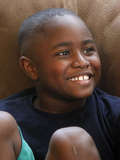
Lisa Wheeler-Brown was rifling through her grandson’s backpack when she found a discipline referral. She was surprised even before she read the report because Cabretti, then 5, was not a troublemaker.
Then she read that the little boy had been written up for assault with a deadly weapon.
It was 2013 and Cabretti was in kindergarten at Maximo Elementary. His grandmother, who is his legal guardian, called the school and demanded to know exactly who Cabretti had attacked, and with what. She wondered why no one had called her. Visions of knives and guns flashed through her mind.
After a few transfers, Wheeler-Brown was connected to someone who could open her grandson’s file. Cabretti, it turned out, had bitten another child who had allegedly bitten him first.
The deadly weapon was his teeth.
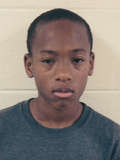
Melrose Elementary was like a bad telemarketer, calling every other day, said Candice Billingsley, a mother of seven.
Often, the calls were about her 11-year-old son, Elijah Crawford, who in 2013 had been retained in third grade and frequently disrupted class. At previous schools, Elijah’s behavior problems typically were handled in school. At Melrose, he would be sent home — and he knew it.
“He was using it as a reward to go home,” Billingsley said.
In the 2013-14 school year, Elijah was suspended from school at least eight times, causing him to fall behind in class. When he was allowed to stay, Elijah sat at a desk in the back of the classroom, turned away from his classmates as a punishment.

Isabella Harris got written up for trying to learn at Lakewood Elementary.
The first-grade girl was sitting on the classroom rug as her teacher tried to round up her classmates for reading time.
But the other children were running around the room, yelling and throwing things, her father, Anthony Harris, said.
Isabella shouted for the other kids to sit down so that she could learn.
Her teacher wrote her up for yelling.
The 7-year-old came home in tears. Harris said it breaks his heart to send her to Lakewood every day. When he asks her how her day was, the answer is never good.

When Jaquan Henderson was 7, he would regularly misbehave in class and get suspended from Lakewood Elementary. His mother, Iesha Coleman, said sometimes she couldn’t even get out of the parking lot before his teachers told her to come get him.
He missed class every week. He would sit at home and watch SpongeBob SquarePants instead.
Then one day in 2008, instead of calling home during a temper tantrum, Jaquan’s teachers pinned him down on the floor and called police, who used the Baker Act to hold him for three days at a mental treatment center.
“He was so little,” said Coleman, adding that Jaquan entered Lakewood knowing how to read, but was later told he couldn’t read or spell.
“They didn’t try with him.”

Lisa Wheeler-Brown was rifling through her grandson’s backpack when she found a discipline referral. She was surprised even before she read the report because Cabretti, then 5, was not a troublemaker.
Then she read that the little boy had been written up for assault with a deadly weapon.
It was 2013 and Cabretti was in kindergarten at Maximo Elementary. His grandmother, who is his legal guardian, called the school and demanded to know exactly who Cabretti had attacked, and with what. She wondered why no one had called her. Visions of knives and guns flashed through her mind.
After a few transfers, Wheeler-Brown was connected to someone who could open her grandson’s file. Cabretti, it turned out, had bitten another child who had allegedly bitten him first.
The deadly weapon was his teeth.

Melrose Elementary was like a bad telemarketer, calling every other day, said Candice Billingsley, a mother of seven.
Often, the calls were about her 11-year-old son, Elijah Crawford, who in 2013 had been retained in third grade and frequently disrupted class. At previous schools, Elijah’s behavior problems typically were handled in school. At Melrose, he would be sent home — and he knew it.
“He was using it as a reward to go home,” Billingsley said.
In the 2013-14 school year, Elijah was suspended from school at least eight times, causing him to fall behind in class. When he was allowed to stay, Elijah sat at a desk in the back of the classroom, turned away from his classmates as a punishment.

Isabella Harris got written up for trying to learn at Lakewood Elementary.
The first-grade girl was sitting on the classroom rug as her teacher tried to round up her classmates for reading time.
But the other children were running around the room, yelling and throwing things, her father, Anthony Harris, said.
Isabella shouted for the other kids to sit down so that she could learn.
Her teacher wrote her up for yelling.
The 7-year-old came home in tears. Harris said it breaks his heart to send her to Lakewood every day. When he asks her how her day was, the answer is never good.

When Jaquan Henderson was 7, he would regularly misbehave in class and get suspended from Lakewood Elementary. His mother, Iesha Coleman, said sometimes she couldn’t even get out of the parking lot before his teachers told her to come get him.
He missed class every week. He would sit at home and watch SpongeBob SquarePants instead.
Then one day in 2008, instead of calling home during a temper tantrum, Jaquan’s teachers pinned him down on the floor and called police, who used the Baker Act to hold him for three days at a mental treatment center.
“He was so little,” said Coleman, adding that Jaquan entered Lakewood knowing how to read, but was later told he couldn’t read or spell.
“They didn’t try with him.”

Lisa Wheeler-Brown was rifling through her grandson’s backpack when she found a discipline referral. She was surprised even before she read the report because Cabretti, then 5, was not a troublemaker.
Then she read that the little boy had been written up for assault with a deadly weapon.
It was 2013 and Cabretti was in kindergarten at Maximo Elementary. His grandmother, who is his legal guardian, called the school and demanded to know exactly who Cabretti had attacked, and with what. She wondered why no one had called her. Visions of knives and guns flashed through her mind.
After a few transfers, Wheeler-Brown was connected to someone who could open her grandson’s file. Cabretti, it turned out, had bitten another child who had allegedly bitten him first.
The deadly weapon was his teeth.

Melrose Elementary was like a bad telemarketer, calling every other day, said Candice Billingsley, a mother of seven.
Often, the calls were about her 11-year-old son, Elijah Crawford, who in 2013 had been retained in third grade and frequently disrupted class. At previous schools, Elijah’s behavior problems typically were handled in school. At Melrose, he would be sent home — and he knew it.
“He was using it as a reward to go home,” Billingsley said.
In the 2013-14 school year, Elijah was suspended from school at least eight times, causing him to fall behind in class. When he was allowed to stay, Elijah sat at a desk in the back of the classroom, turned away from his classmates as a punishment.

Isabella Harris got written up for trying to learn at Lakewood Elementary.
The first-grade girl was sitting on the classroom rug as her teacher tried to round up her classmates for reading time.
But the other children were running around the room, yelling and throwing things, her father, Anthony Harris, said.
Isabella shouted for the other kids to sit down so that she could learn.
Her teacher wrote her up for yelling.
The 7-year-old came home in tears. Harris said it breaks his heart to send her to Lakewood every day. When he asks her how her day was, the answer is never good.

When Jaquan Henderson was 7, he would regularly misbehave in class and get suspended from Lakewood Elementary. His mother, Iesha Coleman, said sometimes she couldn’t even get out of the parking lot before his teachers told her to come get him.
He missed class every week. He would sit at home and watch SpongeBob SquarePants instead.
Then one day in 2008, instead of calling home during a temper tantrum, Jaquan’s teachers pinned him down on the floor and called police, who used the Baker Act to hold him for three days at a mental treatment center.
“He was so little,” said Coleman, adding that Jaquan entered Lakewood knowing how to read, but was later told he couldn’t read or spell.
“They didn’t try with him.”

Lisa Wheeler-Brown was rifling through her grandson’s backpack when she found a discipline referral. She was surprised even before she read the report because Cabretti, then 5, was not a troublemaker.
Then she read that the little boy had been written up for assault with a deadly weapon.
It was 2013 and Cabretti was in kindergarten at Maximo Elementary. His grandmother, who is his legal guardian, called the school and demanded to know exactly who Cabretti had attacked, and with what. She wondered why no one had called her. Visions of knives and guns flashed through her mind.
After a few transfers, Wheeler-Brown was connected to someone who could open her grandson’s file. Cabretti, it turned out, had bitten another child who had allegedly bitten him first.
The deadly weapon was his teeth.

Melrose Elementary was like a bad telemarketer, calling every other day, said Candice Billingsley, a mother of seven.
Often, the calls were about her 11-year-old son, Elijah Crawford, who in 2013 had been retained in third grade and frequently disrupted class. At previous schools, Elijah’s behavior problems typically were handled in school. At Melrose, he would be sent home — and he knew it.
“He was using it as a reward to go home,” Billingsley said.
In the 2013-14 school year, Elijah was suspended from school at least eight times, causing him to fall behind in class. When he was allowed to stay, Elijah sat at a desk in the back of the classroom, turned away from his classmates as a punishment.
When it’s time to go to lunch, the children are slow to line up. The cafeteria is yet another setting for the constant bullying. If it’s not about their looks — their hair, their teeth — it’s about their poor parents and run-down homes. Their stuff is destroyed and they’re left in tears.

Seven-year-old Allana Crawford lay in the road outside Melrose Elementary, sobbing, after a particularly bad day in P.E.
It was midway through the 2013-14 school year, and she had gotten in a fight with another second-grade girl — one of the handful who would tease her about her weight, her shoes, how she wore her hair, her family.
“I don’t want to live anymore,” she told a school employee, who pulled her out of the road to safety.

Jameka Sampson got used to the other kids at Melrose calling her “Miss Piggy” or “Fat Shell.”
In art class or in the lunch room, the second-grade girl with glasses would pretend she didn’t hear it, often wouldn’t even tell her mother.
But when her older brother overheard the taunts, he would start fights, trying to beat up the kids who called his sister fat and pulled on her hair.
With three weeks left in the 2014-15 school year, Jameka’s mother transferred her to Campbell Park, hoping to find an escape from Melrose.
One of the first days at Campbell Park, a girl sitting behind Jameka pulled her hair. This time, she was tired of the taunts. Jameka turned around and hit the girl.
Zaria Anderson was walking to Campbell Park Elementary when the two girls who wouldn’t leave her alone caught sight of her.
All year, they had been following her into the bathroom, calling her names in the lunch room. Now, with weeks left in the 2011-12 school year, they started throwing sticks at 11-year-old Zaria, shouting that she was “scary.”
After a few minutes, one of the girls punched her and pushed her down on the sidewalk outside Campbell Park. Soon both were on top of Zaria, kicking her and punching her. One of the girls gave the other directions: to use an upper cut, exactly how and when to hit her.
The day before, Zaria had filed a bullying report against the girls.
Now she was on the ground, her prescription eyeglasses lost among the leaves — all before the first bell.

Seven-year-old Allana Crawford lay in the road outside Melrose Elementary, sobbing, after a particularly bad day in P.E.
It was midway through the 2013-14 school year, and she had gotten in a fight with another second-grade girl — one of the handful who would tease her about her weight, her shoes, how she wore her hair, her family.
“I don’t want to live anymore,” she told a school employee, who pulled her out of the road to safety.

Jameka Sampson got used to the other kids at Melrose calling her “Miss Piggy” or “Fat Shell.”
In art class or in the lunch room, the second-grade girl with glasses would pretend she didn’t hear it, often wouldn’t even tell her mother.
But when her older brother overheard the taunts, he would start fights, trying to beat up the kids who called his sister fat and pulled on her hair.
With three weeks left in the 2014-15 school year, Jameka’s mother transferred her to Campbell Park, hoping to find an escape from Melrose.
One of the first days at Campbell Park, a girl sitting behind Jameka pulled her hair. This time, she was tired of the taunts. Jameka turned around and hit the girl.
Zaria Anderson was walking to Campbell Park Elementary when the two girls who wouldn’t leave her alone caught sight of her.
All year, they had been following her into the bathroom, calling her names in the lunch room. Now, with weeks left in the 2011-12 school year, they started throwing sticks at 11-year-old Zaria, shouting that she was “scary.”
After a few minutes, one of the girls punched her and pushed her down on the sidewalk outside Campbell Park. Soon both were on top of Zaria, kicking her and punching her. One of the girls gave the other directions: to use an upper cut, exactly how and when to hit her.
The day before, Zaria had filed a bullying report against the girls.
Now she was on the ground, her prescription eyeglasses lost among the leaves — all before the first bell.

Seven-year-old Allana Crawford lay in the road outside Melrose Elementary, sobbing, after a particularly bad day in P.E.
It was midway through the 2013-14 school year, and she had gotten in a fight with another second-grade girl — one of the handful who would tease her about her weight, her shoes, how she wore her hair, her family.
“I don’t want to live anymore,” she told a school employee, who pulled her out of the road to safety.

Jameka Sampson got used to the other kids at Melrose calling her “Miss Piggy” or “Fat Shell.”
In art class or in the lunch room, the second-grade girl with glasses would pretend she didn’t hear it, often wouldn’t even tell her mother.
But when her older brother overheard the taunts, he would start fights, trying to beat up the kids who called his sister fat and pulled on her hair.
With three weeks left in the 2014-15 school year, Jameka’s mother transferred her to Campbell Park, hoping to find an escape from Melrose.
One of the first days at Campbell Park, a girl sitting behind Jameka pulled her hair. This time, she was tired of the taunts. Jameka turned around and hit the girl.
Zaria Anderson was walking to Campbell Park Elementary when the two girls who wouldn’t leave her alone caught sight of her.
All year, they had been following her into the bathroom, calling her names in the lunch room. Now, with weeks left in the 2011-12 school year, they started throwing sticks at 11-year-old Zaria, shouting that she was “scary.”
After a few minutes, one of the girls punched her and pushed her down on the sidewalk outside Campbell Park. Soon both were on top of Zaria, kicking her and punching her. One of the girls gave the other directions: to use an upper cut, exactly how and when to hit her.
The day before, Zaria had filed a bullying report against the girls.
Now she was on the ground, her prescription eyeglasses lost among the leaves — all before the first bell.

Seven-year-old Allana Crawford lay in the road outside Melrose Elementary, sobbing, after a particularly bad day in P.E.
It was midway through the 2013-14 school year, and she had gotten in a fight with another second-grade girl — one of the handful who would tease her about her weight, her shoes, how she wore her hair, her family.
“I don’t want to live anymore,” she told a school employee, who pulled her out of the road to safety.

Jameka Sampson got used to the other kids at Melrose calling her “Miss Piggy” or “Fat Shell.”
In art class or in the lunch room, the second-grade girl with glasses would pretend she didn’t hear it, often wouldn’t even tell her mother.
But when her older brother overheard the taunts, he would start fights, trying to beat up the kids who called his sister fat and pulled on her hair.
With three weeks left in the 2014-15 school year, Jameka’s mother transferred her to Campbell Park, hoping to find an escape from Melrose.
One of the first days at Campbell Park, a girl sitting behind Jameka pulled her hair. This time, she was tired of the taunts. Jameka turned around and hit the girl.
Zaria Anderson was walking to Campbell Park Elementary when the two girls who wouldn’t leave her alone caught sight of her.
All year, they had been following her into the bathroom, calling her names in the lunch room. Now, with weeks left in the 2011-12 school year, they started throwing sticks at 11-year-old Zaria, shouting that she was “scary.”
After a few minutes, one of the girls punched her and pushed her down on the sidewalk outside Campbell Park. Soon both were on top of Zaria, kicking her and punching her. One of the girls gave the other directions: to use an upper cut, exactly how and when to hit her.
The day before, Zaria had filed a bullying report against the girls.
Now she was on the ground, her prescription eyeglasses lost among the leaves — all before the first bell.
The children start to pack up before the final bell. They know their parents, grandparents, guardians will look through their bags when they get home. The adults in their lives wonder why hardly any work is sent home. They’ve written notes to their children’s teachers; why haven’t the teachers responded? When teachers call, it’s almost always when something is wrong. Casual notes from some teachers offer no details: “Kicked by Michael.” Nothing more.
Some parents are so desperate to help their children that they drive them an hour away, or they up and move in search of a better school.

In 2012, Ermarie Otero moved her family close to All Children’s Hospital so that her youngest son, Derek, could get the medical treatments he needs for his severe brain damage.
But that location meant her other son, Ivan, was zoned for Campbell Park Elementary.
Immediately after he started the third grade, Ivan was picked on. He got into a fight. Then, on a Tuesday in early April 2013, Otero got a call from police.
Ivan, then 11, had been eating lunch in the cafeteria with a classmate when another boy tried to slam Ivan’s head into the table. He then punched Ivan in the face repeatedly.
Otero and her husband faced an unthinkable choice. They could move farther north, where Ivan would be assured to get into a safer school, but it would mean less regular treatments for Derek.
They decided to move to Largo.

Master Jeremy Grier started preschool at Melrose Elementary.
He had trouble communicating with his teachers about needing to go to the bathroom; the boy has a speech delay. His teachers put him in a pull-up diaper.
Master Jeremy was suspended from school for pushing a boy who his mother says was aggressive with him — still, while he was in prekindergarten.
Before even starting kindergarten in the Pinellas public schools, Master Jeremy’s parents resolved to avoid the district at all costs.
In the fall of 2014, they were taking three city buses every morning just to get their 6-year-old son to a private school. It took them two hours, round-trip, every day.

Shenyah Ruth’s parents live in a neighborhood zoned for Lakewood Elementary. But they never even considered sending their daughter there. For years they paid for private school.
“The standards and expectations were so much higher than what we were hearing from our public schools,” Shenyah’s mother, Stephanie Ruth, said of the Christian academy.
After elementary school, they played the district’s school assignment lottery and won a coveted seat at Madeira Beach Fundamental K-8.
It was a long commute, but Ruth said it was worth the hassle. Shenyah finished the eighth grade in the spring.
She was happy to drive her daughter 35 minutes each way to avoid the middle schools in south St. Petersburg, which she said have a reputation for being violent and plagued by students who disrupt class.
“We were willing to make the sacrifice. Whatever it took to make sure she got a good education,” Ruth said.

Kimberly Anderson decided to quit her job and homeschool her children rather than let them set foot in Campbell Park Elementary.
Running her own preschool, Anderson watched as children who could recognize and sound out letters fell behind by the second grade at south St. Petersburg schools. “Those were the building blocks of reading,” Anderson said. “And all of a sudden, two years later, the school’s saying they can’t read?”
Anderson isn’t rich, and her life isn’t easy. The home she was raising her children in on 16th Street S was broken into five times, the last time while they were at a Christmas party, coming home to everything in ruins.
But when it came time for her oldest daughter, Olivia, to start kindergarten in 2009, Anderson said it was an easy choice to sacrifice her income.
“I never had to deal with them fighting, or going through that potty-mouth period, wondering where they picked up horrible words,” Anderson said. “Public school was just never an option.”

In 2012, Ermarie Otero moved her family close to All Children’s Hospital so that her youngest son, Derek, could get the medical treatments he needs for his severe brain damage.
But that location meant her other son, Ivan, was zoned for Campbell Park Elementary.
Immediately after he started the third grade, Ivan was picked on. He got into a fight. Then, on a Tuesday in early April 2013, Otero got a call from police.
Ivan, then 11, had been eating lunch in the cafeteria with a classmate when another boy tried to slam Ivan’s head into the table. He then punched Ivan in the face repeatedly.
Otero and her husband faced an unthinkable choice. They could move farther north, where Ivan would be assured to get into a safer school, but it would mean less regular treatments for Derek.
They decided to move to Largo.

Master Jeremy Grier started preschool at Melrose Elementary.
He had trouble communicating with his teachers about needing to go to the bathroom; the boy has a speech delay. His teachers put him in a pull-up diaper.
Master Jeremy was suspended from school for pushing a boy who his mother says was aggressive with him — still, while he was in prekindergarten.
Before even starting kindergarten in the Pinellas public schools, Master Jeremy’s parents resolved to avoid the district at all costs.
In the fall of 2014, they were taking three city buses every morning just to get their 6-year-old son to a private school. It took them two hours, round-trip, every day.

Shenyah Ruth’s parents live in a neighborhood zoned for Lakewood Elementary. But they never even considered sending their daughter there. For years they paid for private school.
“The standards and expectations were so much higher than what we were hearing from our public schools,” Shenyah’s mother, Stephanie Ruth, said of the Christian academy.
After elementary school, they played the district’s school assignment lottery and won a coveted seat at Madeira Beach Fundamental K-8.
It was a long commute, but Ruth said it was worth the hassle. Shenyah finished the eighth grade in the spring.
She was happy to drive her daughter 35 minutes each way to avoid the middle schools in south St. Petersburg, which she said have a reputation for being violent and plagued by students who disrupt class.
“We were willing to make the sacrifice. Whatever it took to make sure she got a good education,” Ruth said.

Kimberly Anderson decided to quit her job and homeschool her children rather than let them set foot in Campbell Park Elementary.
Running her own preschool, Anderson watched as children who could recognize and sound out letters fell behind by the second grade at south St. Petersburg schools. “Those were the building blocks of reading,” Anderson said. “And all of a sudden, two years later, the school’s saying they can’t read?”
Anderson isn’t rich, and her life isn’t easy. The home she was raising her children in on 16th Street S was broken into five times, the last time while they were at a Christmas party, coming home to everything in ruins.
But when it came time for her oldest daughter, Olivia, to start kindergarten in 2009, Anderson said it was an easy choice to sacrifice her income.
“I never had to deal with them fighting, or going through that potty-mouth period, wondering where they picked up horrible words,” Anderson said. “Public school was just never an option.”

In 2012, Ermarie Otero moved her family close to All Children’s Hospital so that her youngest son, Derek, could get the medical treatments he needs for his severe brain damage.
But that location meant her other son, Ivan, was zoned for Campbell Park Elementary.
Immediately after he started the third grade, Ivan was picked on. He got into a fight. Then, on a Tuesday in early April 2013, Otero got a call from police.
Ivan, then 11, had been eating lunch in the cafeteria with a classmate when another boy tried to slam Ivan’s head into the table. He then punched Ivan in the face repeatedly.
Otero and her husband faced an unthinkable choice. They could move farther north, where Ivan would be assured to get into a safer school, but it would mean less regular treatments for Derek.
They decided to move to Largo.

Master Jeremy Grier started preschool at Melrose Elementary.
He had trouble communicating with his teachers about needing to go to the bathroom; the boy has a speech delay. His teachers put him in a pull-up diaper.
Master Jeremy was suspended from school for pushing a boy who his mother says was aggressive with him — still, while he was in prekindergarten.
Before even starting kindergarten in the Pinellas public schools, Master Jeremy’s parents resolved to avoid the district at all costs.
In the fall of 2014, they were taking three city buses every morning just to get their 6-year-old son to a private school. It took them two hours, round-trip, every day.

Shenyah Ruth’s parents live in a neighborhood zoned for Lakewood Elementary. But they never even considered sending their daughter there. For years they paid for private school.
“The standards and expectations were so much higher than what we were hearing from our public schools,” Shenyah’s mother, Stephanie Ruth, said of the Christian academy.
After elementary school, they played the district’s school assignment lottery and won a coveted seat at Madeira Beach Fundamental K-8.
It was a long commute, but Ruth said it was worth the hassle. Shenyah finished the eighth grade in the spring.
She was happy to drive her daughter 35 minutes each way to avoid the middle schools in south St. Petersburg, which she said have a reputation for being violent and plagued by students who disrupt class.
“We were willing to make the sacrifice. Whatever it took to make sure she got a good education,” Ruth said.

Kimberly Anderson decided to quit her job and homeschool her children rather than let them set foot in Campbell Park Elementary.
Running her own preschool, Anderson watched as children who could recognize and sound out letters fell behind by the second grade at south St. Petersburg schools. “Those were the building blocks of reading,” Anderson said. “And all of a sudden, two years later, the school’s saying they can’t read?”
Anderson isn’t rich, and her life isn’t easy. The home she was raising her children in on 16th Street S was broken into five times, the last time while they were at a Christmas party, coming home to everything in ruins.
But when it came time for her oldest daughter, Olivia, to start kindergarten in 2009, Anderson said it was an easy choice to sacrifice her income.
“I never had to deal with them fighting, or going through that potty-mouth period, wondering where they picked up horrible words,” Anderson said. “Public school was just never an option.”

In 2012, Ermarie Otero moved her family close to All Children’s Hospital so that her youngest son, Derek, could get the medical treatments he needs for his severe brain damage.
But that location meant her other son, Ivan, was zoned for Campbell Park Elementary.
Immediately after he started the third grade, Ivan was picked on. He got into a fight. Then, on a Tuesday in early April 2013, Otero got a call from police.
Ivan, then 11, had been eating lunch in the cafeteria with a classmate when another boy tried to slam Ivan’s head into the table. He then punched Ivan in the face repeatedly.
Otero and her husband faced an unthinkable choice. They could move farther north, where Ivan would be assured to get into a safer school, but it would mean less regular treatments for Derek.
They decided to move to Largo.

Master Jeremy Grier started preschool at Melrose Elementary.
He had trouble communicating with his teachers about needing to go to the bathroom; the boy has a speech delay. His teachers put him in a pull-up diaper.
Master Jeremy was suspended from school for pushing a boy who his mother says was aggressive with him — still, while he was in prekindergarten.
Before even starting kindergarten in the Pinellas public schools, Master Jeremy’s parents resolved to avoid the district at all costs.
In the fall of 2014, they were taking three city buses every morning just to get their 6-year-old son to a private school. It took them two hours, round-trip, every day.

Shenyah Ruth’s parents live in a neighborhood zoned for Lakewood Elementary. But they never even considered sending their daughter there. For years they paid for private school.
“The standards and expectations were so much higher than what we were hearing from our public schools,” Shenyah’s mother, Stephanie Ruth, said of the Christian academy.
After elementary school, they played the district’s school assignment lottery and won a coveted seat at Madeira Beach Fundamental K-8.
It was a long commute, but Ruth said it was worth the hassle. Shenyah finished the eighth grade in the spring.
She was happy to drive her daughter 35 minutes each way to avoid the middle schools in south St. Petersburg, which she said have a reputation for being violent and plagued by students who disrupt class.
“We were willing to make the sacrifice. Whatever it took to make sure she got a good education,” Ruth said.

Kimberly Anderson decided to quit her job and homeschool her children rather than let them set foot in Campbell Park Elementary.
Running her own preschool, Anderson watched as children who could recognize and sound out letters fell behind by the second grade at south St. Petersburg schools. “Those were the building blocks of reading,” Anderson said. “And all of a sudden, two years later, the school’s saying they can’t read?”
Anderson isn’t rich, and her life isn’t easy. The home she was raising her children in on 16th Street S was broken into five times, the last time while they were at a Christmas party, coming home to everything in ruins.
But when it came time for her oldest daughter, Olivia, to start kindergarten in 2009, Anderson said it was an easy choice to sacrifice her income.
“I never had to deal with them fighting, or going through that potty-mouth period, wondering where they picked up horrible words,” Anderson said. “Public school was just never an option.”
Parents who do send their children to these schools watch their grades fall steadily. Some of them have already failed standardized tests. Some are repeating grades. They bring home F’s on report cards. They used to be star students, but that was somewhere else.
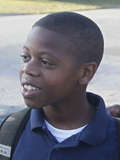
When Cayton Bodden started kindergarten, he didn’t call a square a square. He called it a rhombus. His teachers gawked over how ahead of the class he was, his mother remembers.
But after Lawanda Bodden moved in 2014, her son was zoned for Fairmount Park Elementary. Cayton had been on the honor roll. Within a few months at Fairmount Park, he was bringing home F’s in every subject.
Because of poor scores, district officials said 10-year-old Cayton needed to go to summer school or risk repeating the fourth grade.
In the spring, Cayton’s teacher had recommended him for a program for children who have fallen far behind.
But Bodden said that was not an option for her boy. She said she knows the real reason he was not learning: Cayton was attacked at least five times in the 2014-15 school year. Why would she send him from one troubled setting to another?

In reports home from Maximo Elementary, Tyree Parker’s kindergarten teacher said he couldn’t identify shapes or do simple counting exercises.
That would be bad on its face. But what made it so much worse, his grandmother said, was that Tyree’s pre-K records show he mastered these concepts the year before.
Loneiyce Washington was not surprised Tyree was falling behind. He had to switch classrooms midway through the 2014-15 school year to escape a bully, one who destroyed his Ninja Turtles cap and called him gap-toothed and ugly. In his new class, another child followed him into the bathroom, pushed him to the floor, and ripped the 6-year-old’s pants.
His grandmother wondered: How can you worry about learning when you are worried about survival?
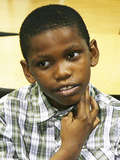
Years had passed since Tashawn Roberts got an honor roll certificate home, his mother lamented in early 2015.
On a recent intelligence test, Tashawn had recorded a 135 IQ, Teyosha Pippen said. He began receiving gifted services in the fourth grade at Campbell Park.
But at the same time, his A’s and B’s had slipped to C’s and D’s.
Tashawn was bullied, got in fights and was sent home all the time. His teachers said they couldn’t control him. His mother had him tested for attention disorders twice.
“The doctor said the only thing wrong with Tashawn is that he’s too smart,” Pippen said.

When Cayton Bodden started kindergarten, he didn’t call a square a square. He called it a rhombus. His teachers gawked over how ahead of the class he was, his mother remembers.
But after Lawanda Bodden moved in 2014, her son was zoned for Fairmount Park Elementary. Cayton had been on the honor roll. Within a few months at Fairmount Park, he was bringing home F’s in every subject.
Because of poor scores, district officials said 10-year-old Cayton needed to go to summer school or risk repeating the fourth grade.
In the spring, Cayton’s teacher had recommended him for a program for children who have fallen far behind.
But Bodden said that was not an option for her boy. She said she knows the real reason he was not learning: Cayton was attacked at least five times in the 2014-15 school year. Why would she send him from one troubled setting to another?

In reports home from Maximo Elementary, Tyree Parker’s kindergarten teacher said he couldn’t identify shapes or do simple counting exercises.
That would be bad on its face. But what made it so much worse, his grandmother said, was that Tyree’s pre-K records show he mastered these concepts the year before.
Loneiyce Washington was not surprised Tyree was falling behind. He had to switch classrooms midway through the 2014-15 school year to escape a bully, one who destroyed his Ninja Turtles cap and called him gap-toothed and ugly. In his new class, another child followed him into the bathroom, pushed him to the floor, and ripped the 6-year-old’s pants.
His grandmother wondered: How can you worry about learning when you are worried about survival?

Years had passed since Tashawn Roberts got an honor roll certificate home, his mother lamented in early 2015.
On a recent intelligence test, Tashawn had recorded a 135 IQ, Teyosha Pippen said. He began receiving gifted services in the fourth grade at Campbell Park.
But at the same time, his A’s and B’s had slipped to C’s and D’s.
Tashawn was bullied, got in fights and was sent home all the time. His teachers said they couldn’t control him. His mother had him tested for attention disorders twice.
“The doctor said the only thing wrong with Tashawn is that he’s too smart,” Pippen said.

When Cayton Bodden started kindergarten, he didn’t call a square a square. He called it a rhombus. His teachers gawked over how ahead of the class he was, his mother remembers.
But after Lawanda Bodden moved in 2014, her son was zoned for Fairmount Park Elementary. Cayton had been on the honor roll. Within a few months at Fairmount Park, he was bringing home F’s in every subject.
Because of poor scores, district officials said 10-year-old Cayton needed to go to summer school or risk repeating the fourth grade.
In the spring, Cayton’s teacher had recommended him for a program for children who have fallen far behind.
But Bodden said that was not an option for her boy. She said she knows the real reason he was not learning: Cayton was attacked at least five times in the 2014-15 school year. Why would she send him from one troubled setting to another?

In reports home from Maximo Elementary, Tyree Parker’s kindergarten teacher said he couldn’t identify shapes or do simple counting exercises.
That would be bad on its face. But what made it so much worse, his grandmother said, was that Tyree’s pre-K records show he mastered these concepts the year before.
Loneiyce Washington was not surprised Tyree was falling behind. He had to switch classrooms midway through the 2014-15 school year to escape a bully, one who destroyed his Ninja Turtles cap and called him gap-toothed and ugly. In his new class, another child followed him into the bathroom, pushed him to the floor, and ripped the 6-year-old’s pants.
His grandmother wondered: How can you worry about learning when you are worried about survival?

Years had passed since Tashawn Roberts got an honor roll certificate home, his mother lamented in early 2015.
On a recent intelligence test, Tashawn had recorded a 135 IQ, Teyosha Pippen said. He began receiving gifted services in the fourth grade at Campbell Park.
But at the same time, his A’s and B’s had slipped to C’s and D’s.
Tashawn was bullied, got in fights and was sent home all the time. His teachers said they couldn’t control him. His mother had him tested for attention disorders twice.
“The doctor said the only thing wrong with Tashawn is that he’s too smart,” Pippen said.

When Cayton Bodden started kindergarten, he didn’t call a square a square. He called it a rhombus. His teachers gawked over how ahead of the class he was, his mother remembers.
But after Lawanda Bodden moved in 2014, her son was zoned for Fairmount Park Elementary. Cayton had been on the honor roll. Within a few months at Fairmount Park, he was bringing home F’s in every subject.
Because of poor scores, district officials said 10-year-old Cayton needed to go to summer school or risk repeating the fourth grade.
In the spring, Cayton’s teacher had recommended him for a program for children who have fallen far behind.
But Bodden said that was not an option for her boy. She said she knows the real reason he was not learning: Cayton was attacked at least five times in the 2014-15 school year. Why would she send him from one troubled setting to another?

In reports home from Maximo Elementary, Tyree Parker’s kindergarten teacher said he couldn’t identify shapes or do simple counting exercises.
That would be bad on its face. But what made it so much worse, his grandmother said, was that Tyree’s pre-K records show he mastered these concepts the year before.
Loneiyce Washington was not surprised Tyree was falling behind. He had to switch classrooms midway through the 2014-15 school year to escape a bully, one who destroyed his Ninja Turtles cap and called him gap-toothed and ugly. In his new class, another child followed him into the bathroom, pushed him to the floor, and ripped the 6-year-old’s pants.
His grandmother wondered: How can you worry about learning when you are worried about survival?

Years had passed since Tashawn Roberts got an honor roll certificate home, his mother lamented in early 2015.
On a recent intelligence test, Tashawn had recorded a 135 IQ, Teyosha Pippen said. He began receiving gifted services in the fourth grade at Campbell Park.
But at the same time, his A’s and B’s had slipped to C’s and D’s.
Tashawn was bullied, got in fights and was sent home all the time. His teachers said they couldn’t control him. His mother had him tested for attention disorders twice.
“The doctor said the only thing wrong with Tashawn is that he’s too smart,” Pippen said.
They know there are better options out there. Schools just a few miles away where classrooms aren’t constantly disrupted and where children learn. But these are special schools, magnet programs with limited space. Families from across the county clamor to get their children in.
Not everyone can win the lottery.
This year, more than 2,000 children are stuck at five of the worst elementary schools in Florida. Many have no way to get out.

Alicia Davis tried to get her son, Altez Rowe, a seat at Perkins Elementary, a magnet school with a strong reputation. But Altez didn’t win a seat.
She tried to enroll him at Marjorie Kinnan Rawlings Elementary in Pinellas Park through the school system’s choice program. But the school district offered another school that was too far for the single mother to drive.
So in 2014, 6-year-old Altez ended up enrolling in kindergarten at Fairmount Park Elementary.
“The only reason he’s going there,” Davis said, “is that I couldn’t get in anywhere else.”
Davis had heard Fairmount Park, her zoned school, was “a bad school.” She began to believe that at an open house, when only one other parent in her son’s class showed up. Then, on the second day of school, Altez got in a fight on the school bus. He began using curse words, and his mother began worrying that he wasn’t learning. That none of the kids in his class were.

As a kindergartner, Alvin Lyons Jr. won a spot at Douglas L. Jamerson Jr. Elementary, a popular magnet program that attracts children from across the county.
But his behavior meant he couldn’t keep it.
Alvin had a hard time controlling himself in the classroom, said the Rev. James Holt, his grandfather. It was not out of character for the boy to climb on his desk and scream at his teacher.
Facing dismissal from Jamerson, Alvin’s parents enrolled him in his neighborhood school, Fairmount Park Elementary, where the 9-year-old was in the fourth grade in 2014-15.
Holt said he believes the district is designed to steer the most challenged students to a handful of schools. Magnet schools and other programs with limited seats make up the top tier. They can cherry pick the best students and send troublemakers back to their regular neighborhood schools, he said.
“It becomes a housing area for kids with behavior problems,” he said. “If you can’t make it at a Jamerson, they’re going to get you rerouted to a Fairmount or a Melrose. And then, before you know it, Melrose and Fairmount have all the same children who have behavior issues.”

Tanisha Wooten was thrilled when her oldest son won a seat at a fundamental school. But even though special schools sometimes take siblings, too, there weren’t enough seats for her youngest son, Jaymir.
Instead, Jaymir had to go to Lakewood Elementary. A first-grader in 2014-15, Jaymir always came home with an empty backpack. His mother would shake her head, wondering why he never got work sent home.
Jaymir, who did not turn 7 until the summer, was one of the smallest boys in class. In a quiet voice, he said he was picked on in the cafeteria by bigger boys. His favorite “subject” was lunch on Fridays, the day his teacher let him eat in his classroom, with the other children who were afraid.

Alicia Davis tried to get her son, Altez Rowe, a seat at Perkins Elementary, a magnet school with a strong reputation. But Altez didn’t win a seat.
She tried to enroll him at Marjorie Kinnan Rawlings Elementary in Pinellas Park through the school system’s choice program. But the school district offered another school that was too far for the single mother to drive.
So in 2014, 6-year-old Altez ended up enrolling in kindergarten at Fairmount Park Elementary.
“The only reason he’s going there,” Davis said, “is that I couldn’t get in anywhere else.”
Davis had heard Fairmount Park, her zoned school, was “a bad school.” She began to believe that at an open house, when only one other parent in her son’s class showed up. Then, on the second day of school, Altez got in a fight on the school bus. He began using curse words, and his mother began worrying that he wasn’t learning. That none of the kids in his class were.

As a kindergartner, Alvin Lyons Jr. won a spot at Douglas L. Jamerson Jr. Elementary, a popular magnet program that attracts children from across the county.
But his behavior meant he couldn’t keep it.
Alvin had a hard time controlling himself in the classroom, said the Rev. James Holt, his grandfather. It was not out of character for the boy to climb on his desk and scream at his teacher.
Facing dismissal from Jamerson, Alvin’s parents enrolled him in his neighborhood school, Fairmount Park Elementary, where the 9-year-old was in the fourth grade in 2014-15.
Holt said he believes the district is designed to steer the most challenged students to a handful of schools. Magnet schools and other programs with limited seats make up the top tier. They can cherry pick the best students and send troublemakers back to their regular neighborhood schools, he said.
“It becomes a housing area for kids with behavior problems,” he said. “If you can’t make it at a Jamerson, they’re going to get you rerouted to a Fairmount or a Melrose. And then, before you know it, Melrose and Fairmount have all the same children who have behavior issues.”

Tanisha Wooten was thrilled when her oldest son won a seat at a fundamental school. But even though special schools sometimes take siblings, too, there weren’t enough seats for her youngest son, Jaymir.
Instead, Jaymir had to go to Lakewood Elementary. A first-grader in 2014-15, Jaymir always came home with an empty backpack. His mother would shake her head, wondering why he never got work sent home.
Jaymir, who did not turn 7 until the summer, was one of the smallest boys in class. In a quiet voice, he said he was picked on in the cafeteria by bigger boys. His favorite “subject” was lunch on Fridays, the day his teacher let him eat in his classroom, with the other children who were afraid.

Alicia Davis tried to get her son, Altez Rowe, a seat at Perkins Elementary, a magnet school with a strong reputation. But Altez didn’t win a seat.
She tried to enroll him at Marjorie Kinnan Rawlings Elementary in Pinellas Park through the school system’s choice program. But the school district offered another school that was too far for the single mother to drive.
So in 2014, 6-year-old Altez ended up enrolling in kindergarten at Fairmount Park Elementary.
“The only reason he’s going there,” Davis said, “is that I couldn’t get in anywhere else.”
Davis had heard Fairmount Park, her zoned school, was “a bad school.” She began to believe that at an open house, when only one other parent in her son’s class showed up. Then, on the second day of school, Altez got in a fight on the school bus. He began using curse words, and his mother began worrying that he wasn’t learning. That none of the kids in his class were.

As a kindergartner, Alvin Lyons Jr. won a spot at Douglas L. Jamerson Jr. Elementary, a popular magnet program that attracts children from across the county.
But his behavior meant he couldn’t keep it.
Alvin had a hard time controlling himself in the classroom, said the Rev. James Holt, his grandfather. It was not out of character for the boy to climb on his desk and scream at his teacher.
Facing dismissal from Jamerson, Alvin’s parents enrolled him in his neighborhood school, Fairmount Park Elementary, where the 9-year-old was in the fourth grade in 2014-15.
Holt said he believes the district is designed to steer the most challenged students to a handful of schools. Magnet schools and other programs with limited seats make up the top tier. They can cherry pick the best students and send troublemakers back to their regular neighborhood schools, he said.
“It becomes a housing area for kids with behavior problems,” he said. “If you can’t make it at a Jamerson, they’re going to get you rerouted to a Fairmount or a Melrose. And then, before you know it, Melrose and Fairmount have all the same children who have behavior issues.”

Tanisha Wooten was thrilled when her oldest son won a seat at a fundamental school. But even though special schools sometimes take siblings, too, there weren’t enough seats for her youngest son, Jaymir.
Instead, Jaymir had to go to Lakewood Elementary. A first-grader in 2014-15, Jaymir always came home with an empty backpack. His mother would shake her head, wondering why he never got work sent home.
Jaymir, who did not turn 7 until the summer, was one of the smallest boys in class. In a quiet voice, he said he was picked on in the cafeteria by bigger boys. His favorite “subject” was lunch on Fridays, the day his teacher let him eat in his classroom, with the other children who were afraid.

Alicia Davis tried to get her son, Altez Rowe, a seat at Perkins Elementary, a magnet school with a strong reputation. But Altez didn’t win a seat.
She tried to enroll him at Marjorie Kinnan Rawlings Elementary in Pinellas Park through the school system’s choice program. But the school district offered another school that was too far for the single mother to drive.
So in 2014, 6-year-old Altez ended up enrolling in kindergarten at Fairmount Park Elementary.
“The only reason he’s going there,” Davis said, “is that I couldn’t get in anywhere else.”
Davis had heard Fairmount Park, her zoned school, was “a bad school.” She began to believe that at an open house, when only one other parent in her son’s class showed up. Then, on the second day of school, Altez got in a fight on the school bus. He began using curse words, and his mother began worrying that he wasn’t learning. That none of the kids in his class were.

As a kindergartner, Alvin Lyons Jr. won a spot at Douglas L. Jamerson Jr. Elementary, a popular magnet program that attracts children from across the county.
But his behavior meant he couldn’t keep it.
Alvin had a hard time controlling himself in the classroom, said the Rev. James Holt, his grandfather. It was not out of character for the boy to climb on his desk and scream at his teacher.
Facing dismissal from Jamerson, Alvin’s parents enrolled him in his neighborhood school, Fairmount Park Elementary, where the 9-year-old was in the fourth grade in 2014-15.
Holt said he believes the district is designed to steer the most challenged students to a handful of schools. Magnet schools and other programs with limited seats make up the top tier. They can cherry pick the best students and send troublemakers back to their regular neighborhood schools, he said.
“It becomes a housing area for kids with behavior problems,” he said. “If you can’t make it at a Jamerson, they’re going to get you rerouted to a Fairmount or a Melrose. And then, before you know it, Melrose and Fairmount have all the same children who have behavior issues.”

Tanisha Wooten was thrilled when her oldest son won a seat at a fundamental school. But even though special schools sometimes take siblings, too, there weren’t enough seats for her youngest son, Jaymir.
Instead, Jaymir had to go to Lakewood Elementary. A first-grader in 2014-15, Jaymir always came home with an empty backpack. His mother would shake her head, wondering why he never got work sent home.
Jaymir, who did not turn 7 until the summer, was one of the smallest boys in class. In a quiet voice, he said he was picked on in the cafeteria by bigger boys. His favorite “subject” was lunch on Fridays, the day his teacher let him eat in his classroom, with the other children who were afraid.
So.
They go home. They eat dinner. They watch cartoons. They climb into bed.
Then they set the alarm clocks.
Times Staff Writers Cara Fitzpatrick and Michael LaForgia contributed to this report. Contact Lisa Gartner at [email protected]. Follow her @lisagartner.
Here are more than three dozen children affected by resegregated elementary schools in south St. Petersburg.
Here’s how many felt shortchanged out of a good education.
Even more lost class time to discipline or disruption.
This many feared going to school.
More than a few were making strong progress somewhere else, then lost ground here.
Here’s how many were zoned for the five schools, but their parents were able to get them out.
These are their stories.
Search kids
Filter kids by tags
Filter kids by school

Allana Crawford
Melrose Elementary School
Halfway through Allana Crawford’s second-grade year at Melrose Elementary, the bullying had become too much.
An especially bad day on the P.E. field brought her to a breaking point. Allana got in a fight with another girl — one of the handful who would tease her about her weight, her shoes, how she wore her hair, her family. Soon after, Allana sat down in the road in front of school, in the path of oncoming cars, and refused to get up. “I don't want to live anymore,” she told a school employee.
For Allana’s mother, Candice Billingsley, the episode captures her children’s experience at Melrose, where, Billingsley said, classroom behavior at times was completely out of control. During the 2013-14 school year, Billingsley said, she saw children roaming the halls during class time and boys climbing on desks while the teachers addressed the class. She said the children had the run of the place, and her daughter’s grades were slipping as a result.
Billingsley recalls a meeting with the principal, Nanette Grasso, in which the mother pleaded for a way to keep her children safe. She said the principal replied: The only way you can keep them safe is if you sit in the classroom all day, every day. “That was shocking,” Billingsley said.
In an email, Grasso said “the incident and family is not representative of our Melrose students/families and due to confidentiality regarding this particular family and students, I am not at liberty to share with you all of the details surrounding this family; I can assure you that this response was not part of our conversation.”
Since then, Billingsley, a single mother of seven, got placed for Section 8 housing in Largo, and Allana moved to Ridgecrest Elementary for the third grade. The differences are stark, Billingsley said. Where before it was all she could do to get her daughter to go to school, now the little girl is on the honor roll.

Altez Rowe
Fairmount Park Elementary School
Altez Rowe finished kindergarten at Fairmount Park Elementary in the spring of 2015.
“The only reason he’s going there,” said his mother, Alicia Davis, “is that I couldn’t get in anywhere else.”
Davis had entered her son in the school district’s special assignment lottery. She wanted Perkins Elementary, a nearby magnet school with a strong reputation. Altez didn't get a seat.
She tried to enroll him at Marjorie Kinnan Rawlings Elementary in Pinellas Park through the school system's choice program. But the school district offered another school that was too far for the single mother to drive.
Davis had heard Fairmount Park, her zoned school, was “a bad school.” She began to believe that at an open house, when only one other parent in her son's class showed up. Then, on the second day of school, Altez got in a fight on the school bus.
It was a small scrap, Davis said, and the only referral her son received that year. But it's not the only reason Davis said she needed to get her son out of Fairmount Park.
Altez picked up rude words and crude behaviors, she said. Her little brother and her niece attended kindergarten at North Shore Elementary, in a wealthier part of St. Petersburg, and “I can tell the difference (in education) in the way they interact. They use bigger words and they have better grammar” than her son, Davis said.
Even in the span of his kindergarten year, Altez's grades fell, his mother said.
Davis said she would move her son for the 2015-16 school year, no matter what, even if it meant accepting an assignment from the school district that's far from their home.
“Being that I’m a single parent, and I'm young, and I have a full-time job, I try — but I guess I’m going to have to try a little harder next year,” said Davis, who is 22. “I'm going to end up doing whatever I have to do. I don't even know.”
Just before the new school year started, the district offered Altez a seat at a D-rated elementary school in northeast St. Petersburg.
“We’re really excited,” his mother said.

Alvin Lyons Jr.
Fairmount Park Elementary School
As a kindergartner, Alvin Lyons Jr. won a coveted spot at Douglas L. Jamerson Jr. Elementary, a popular magnet program that children from across Pinellas compete to attend.
But his behavior meant he couldn’t keep it.
Alvin has a hard time controlling himself in the classroom, according to his grandfather, the Rev. James Holt. It’s not out of character for the boy to climb on top of his desk and scream at his teacher, Holt said.
With Alvin facing dismissal from Jamerson, his parents enrolled him in his neighborhood school, Fairmount Park Elementary, where Alvin was a fourth-grader in the 2014-15 school year.
Holt blames the district’s two-tiered system of neighborhood schools and magnets. The special schools get to keep only the best-behaved students. The neighborhood schools, he said, are seemingly designed to absorb the problem children rejected by the top.
“It becomes a housing area for kids with behavior problems,” he said of the district’s regular schools. “If you can't make it at a Jamerson, they're going to get you rerouted to a Fairmount or a Melrose. And then, before you know it, Melrose and Fairmount have all the same children who have behavior issues.”
“The sad fact is that when I look at the system now, it’s producing some kids that the system has said, ‘We’re not going to put anything behind you because we know you’re not going to make it,’ ” Holt said. "In reality, we have already committed ourselves to thinking, ‘You're not going to be the next doctor, lawyer. You're not going to be a person who has a good job.’ ”
With his grandson struggling in school, Holt said the only thing he can do is try to get more involved. If they come together as a family, he reasons, maybe they can salvage something of an education for the boy.
"Hopefully with us working together we can get him to be a pretty sharp student,” Holt said. “Hopefully get him to a level where he can survive out there in this world."

Amariyon Johnson
Campbell Park Elementary School
One day in the fall of 2014, Amariyon came home from Campbell Park with bruises all over his face.
“What happened?” asked Kaheima Williams, dropping to the floor next to her son.
The boy told his mother that another fourth-grade student had hit him while swinging a chair in the middle of class.
Williams was horrified. Her son had been in a shoving fight once before, but now she began to suspect things were worse than she had imagined.
So she went to observe her son’s class. There, she said, she watched children jump out of their seats, run around and shout while their teacher struggled to control the class.
Williams said she started to understand why her son had failed state standardized tests. “I don’t know that he’s able to talk to the teacher because she’s constantly interrupted,” she said.
She wondered how he, or anyone, could learn in this kind of setting.
Amariyon earned decent grades, even making the honor roll once, but he rarely received homework. When he did, he couldn't understand how to do it. Williams worried his teachers just passed him along from one grade to the next. She said she wrote to his fourth-grade teacher several times, asking where his homework was, asking if there was more she could be doing at home. She was looking for guidance, something many St. Petersburg parents say they’ve tried.
Their children come home each day with a calendar, which parents and teachers can use to exchange hand-written notes.
"When will you send work home?” Williams wrote in her son's planner often. She hoped for a response. She said she rarely received one.
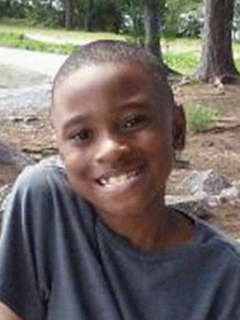
Anthonio Newton Jr.
James B. Sanderlin IB World School
It can be a challenge to have Anthonio Newton Jr. in class.
Loud noises bother him. So do changes in his routine. When he gets upset, he ignores his teacher and, sometimes, tears posters off the classroom wall or throws things. He was suspended five times in kindergarten, said his mother, Patrice Coleman. Then he was diagnosed with oppositional defiance disorder and ADHD.
But Coleman considers her son lucky.
Entering kindergarten, he won a seat at James B. Sanderlin PK-8 IB World School, an A-rated magnet school in St. Petersburg, through the school district’s lottery for special programs. He was zoned for F-rated Maximo Elementary.
Getting Anthonio diagnosed was a “very trying and tumultuous time” for the family, Coleman said. But she said that the principal and assistant principal at Sanderlin worked with Anthonio.
Because he was succeeding academically, the school staff focused on behavior. They created a reward system to encourage him to behave well. They found a kindergarten teacher he had a rapport with and then allowed him to follow her when she became a first-grade teacher the next year.
Coleman said the school never had an “attitude” about her child. She’s not sure another school, particularly one with a lot of other difficult students, would have been able to do as much for Anthonio.
“He probably would have been shipped somewhere else,” she said.
And Sanderlin’s approach has worked.
In Anthonio’s first two years at Sanderlin, Coleman received a lot of calls from the school about his behavior. But by the time he reached the second grade in 2014-15, there were hardly any calls at all.

Asha Whiting
Bay Vista Fundamental
“How did you do it?”
Asha Whiting gets this question a lot. So does her mother, Tanasha. Everyone wants to know how they got so lucky to win a seat at a fundamental school, saving Asha from attending one of south St. Petersburg’s neighborhood schools.
In Pinellas, the special assignment lottery can be a ticket to a magnet or fundamental school, which take a “back to basics approach,” requiring parental involvement, strict dress codes, and top-tier behavior. Anyone who misbehaves can be kicked out. Fundamentals are consistently A-schools, dramatically different from the F-rated neighborhood schools throughout south St. Petersburg.
But most people who apply don’t get in because there isn’t enough space.
Whiting and her husband are from the Virgin Islands, and Whiting is quick to say she doesn't know what the fuss is all about. They didn't have lotteries like this there. She just knows that she put down a few schools she wanted Asha to attend, and they got a seat at Bay Vista Fundamental Elementary School.
“Everyone asks, what did you do? How did you do it? But I didn't do anything special,” Whiting said in the spring. “Everyone was so amazed.”
Asha has received a good education. Her grades are average, mostly B’s and C’s with an A here or there. Her fifth-grade teacher tutored her after school in math, her weak spot. Overall, it's gone well. “I don't have any complaints,” Whiting said.
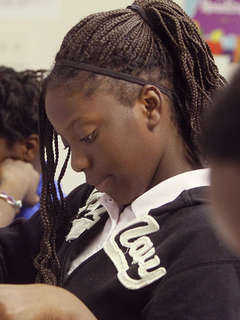
Asya Dickinson
Fairmount Park Elementary School
Asya Dickinson was making a good go of it at Marjorie Kinnan Rawlings Elementary when her family moved to a new house zoned for Fairmount Park Elementary.
Her grandmother, Maxine Stewart, walked into the school’s administration office to register Asya.
“I didn’t like what I saw,” the grandmother remembered.
The staff was cold to the children, she said. Teachers were young and cutting their teeth. When teachers disciplined students, she said, it amounted to screaming at them.
Desperate to find a good school for her granddaughter, Stewart had already sent Asya to three different campuses. She had started out at Maximo, but left after the school earned two consecutive F grades.
Despite the tumult of switching schools so often, Stewart felt Asya could not stay at Fairmount. She called the district and told them to get her out.
After she ended up back at Maximo, Asya left the district completely.
At her new school, a small private campus she attended with financial aid, she was finally okay, her grandmother said. In the 2014-15 school year, fifth-grader Asya was bringing home A’s and B’s on her report cards, and Stewart said she knew her granddaughter was getting a good education.

Avontrell Hazzard
Maximo Elementary School
When it was time for Avontrell Hazzard to start kindergarten, his family entered him in the school district's special lottery for magnet and fundamental schools.
But all he got was a spot on the waiting list, so Avontrell's journey through the Pinellas public school system started at his neighborhood school: Maximo Elementary.
Cheryl Watson, Avontrell's grandmother, said the school was “chaotic” and the actions they chose to try to get kids under control puzzled the family.
Kindergarten students were given referrals for not walking in a straight line. Watson said. “I thought it was ridiculous to be so strict on a kindergartener,” she said.
Although his teacher rarely contacted her, Watson remembered one day when Avontrell came home with a note in his agenda. It said that Avontrell had been disruptive in class, "and if he does that again he will get a referral."
"I was supposed to sign it, but I didn't because I just thought that was a little ridiculous," Watson said.
Eventually, Avontrell got off the wait list and into a magnet school. After a few more tumultuous years in the public schools, his family decided on a private education for his middle school years.
At a Christian school in south St. Pete, he often makes honor roll and enjoys studying math.
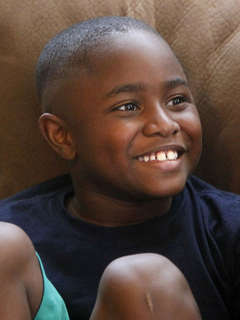
Cabretti Wheeler Jr.
Maximo Elementary School
Lisa Wheeler-Brown was rifling through her grandson’s backpack when she found a discipline referral. She was surprised even before she read the report because her Cabretti, then 5, was not a troublemaker.
Then she read that her little grandson had been written up for assault with a deadly weapon.
It was 2013, and Cabretti Wheeler, Jr., was in the kindergarten at Maximo Elementary. His grandmother, who is his legal guardian, called the school and demanded to know exactly who Cabretti had attacked, and with what. She wondered why no one had called her. Visions of knives and guns flashed through her mind.
After a few transfers, Wheeler-Brown was connected to someone who could open her grandson’s file. Cabretti, it turned out, had bitten another child who had allegedly bitten him first.
The deadly weapon was his teeth.

Cayton Bodden
Fairmount Park Elementary School
Lawanda Bodden tried to avoid sending her son Cayton to Fairmount Park Elementary.
She sent him to a charter school that closed. She tried to get him into higher-performing schools, like the A-rated magnet school right down the street. But there weren’t enough open seats. When she begged the district, they offered her Shore Acres Elementary, a mostly white school in northeast St. Petersburg. But the district wouldn’t send a bus to get Cayton to school and it was too far for the single working mother to drive.
So in 2014, Cayton enrolled at Fairmount. He started kindergarten calling squares "rhombuses," obviously bright. But after a few months at Fairmount Park, Cayton was earning F's in everything but physical education and art.
Because of poor scores, district officials told 10-year-old Cayton he needed to go to a special summer session or risk being held back.
Bodden thinks the real problem is fear. She said her son was hit twice in the school’s cafeteria. One day in the hall, another boy kicked him, just because Cayton was standing there. She said he dreads going to school because of the bullying.
"I felt like I'm setting my child up for failure," Bodden said. "I have no control over what education I can give my child. Unless I made enough money to send him to a private school or stay at home and teach him, this was the only option I had.
"It's really like a parent being put in a maze and we have no way out of it."

Elijah Crawford
Melrose Elementary School
Melrose Elementary was like a bad telemarketer, calling every other day, said Candice Billingsley, a mother of seven.
Often, the calls were about her 11-year-old son, Elijah Crawford, who had been retained in third grade and frequently disrupted class.
At previous schools, Elijah's behavior problems typically were handled in school. His teachers would talk to him, and try to get at the root problem causing his behavior.
But at Melrose Elementary, he would simply be sent home — and he knew it.
"He was using it as a reward to go home," Billingsley said.
Other districts across Florida have suspension centers, places where children can go to receive instruction and counseling instead of home, where they might watch television or play video games.
These districts also have strict guidelines that prevent a child from being suspended over minor infractions like talking in class.
But Elijah found out firsthand that Pinellas did not.
Elijah was suspended out of school more than eight times in the 2013-14 school year, causing him to fall behind in class. When he was allowed to stay, Elijah sat at a desk in the back of the classroom, turned away from his classmates as a punishment.
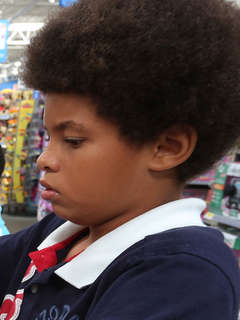
Elijah Redix
Melrose Elementary School
Elijah Redix's experiences at Melrose Elementary are a world apart from what he knew at his previous schools.
He came to Melrose, his neighborhood school, as a fifth-grader in 2014 after struggling at two other elementary schools — a strict private academy and a public “fundamental” school, where behavior rules are strictly enforced and noncompliant students are dismissed.
Straightaway, Elijah made the honor roll. His father, Eric Redix, said that was because Elijah was repeating work he already learned at the other schools.
Even worse, he said, were the behavior problems surrounding his son.
Thinking Elijah had insulted him, another student once got up in the middle of a lesson and jumped him, Redix said. School officials called police, and Elijah emerged from the fray with bruises and bite marks — and still more class time lost to disruption.
“These kids are rough,” Redix said. “They talk trash to each other. You should hear how some of these kids talk. They come to school and cuss more than some of these adults. It’s crazy. And they don’t have any respect for authority.”

Errianna Philpot
Campbell Park Elementary School
Once upon a time, Quisha Simmons went to Campbell Park Elementary.
She got a good education and went on to attend the demanding International Baccalaureate program at St. Petersburg High School. She has a good job.
But when it came time to send her own daughter, Errianna Philpot, to Campbell Park, Simmons couldn’t do it.
Today, Campbell Park is an F school and student performance there is among the worst in the state on standardized tests. Simmons knew all this. So, in 2014, she entered the district’s lottery for a special seat assignment.
Errianna won a seat at James B. Sanderlin PK-8 IB World School, the kindergartener was doing great, her mother said in the spring. Simmons likes the pre-IB program, given that she did IB herself.
Simmons said she gets goosebumps when she thinks of what would have happened if she had not won the lottery. At the same time Errianna was in kindergarten at Sanderlin, Simmons had two nieces in kindergarten at Campbell Park. They learned so much less this year than Errianna, Simmons said. “They're not learning anything.”

Isabella Harris
Lakewood Elementary School
In the spring of 2015, Isabella was in the first grade. When she came home each day from Lakewood Elementary, her father would ask how her day was, and then brace himself.
The answer was never good.
Her teacher couldn’t control her first-grade classroom, she told her father. Fights broke out. When it was time to read on the rug, kids were all over the place, screaming.
One day, Isabella stood up on the rug and shouted for everyone to sit down and be quiet. She wanted to learn.
Instead she was written up. It’s the only formal discipline Isabella has received.
Although Isabella kept her grades up, her father wondered how much she was learning. He noticed Isabella never had spelling tests, basics that he remembered from school.
Several times he had entered Isabella's name in the school district’s lottery for a seat at another school, but the only thing they were ever been offered was in north Pinellas County, an hour away.

Isaiah Carter
Marjorie Kinnan Rawlings Elementary School
Isaiah Carter and his little sister go to Marjorie Kinnan Rawlings Elementary, a school they petitioned the district to attend, away from their south St. Petersburg neighborhood.
“So far, honestly and truthfully, I can’t complain,” said his mother, Alicia Franklin-Penix, in the spring. “I’m very thankful. My children are having some behavior issues, but they’re getting them under control.”
Franklin-Penix said her son, entering the third grade, used to rack up referrals for defiance. He would “get an attitude” when he didn’t want to do an assignment in class, pouting and refusing to cooperate with teachers.
But Rawlings’ staff was committed to turning things around for her son, Franklin-Penix said. They developed a “redirection plan” wherein she meets every six weeks with a team of school staff who are trying to help her son succeed.
The school always calls her when Isaiah is being disruptive, instead of immediately assigning a disciplinary consequence.
As a result, Isaiah has never been suspended from class. His behavior is improving, his mother said.
“They’re not labeling my children,” Franklin-Penix said. “They’re seeking ways to get on top of them. “Most people would rather slap a label on a child than deal with it, but they go the extra mile for my children.”
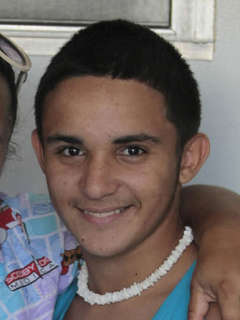
Ivan Rivera-Otero
Campbell Park Elementary School
A powerful desire to do what was best for her children drove Ermarie Otero and her husband to interrupt their lives and move their family from Kissimmee to St. Petersburg.
It was a decision with roots in a family tragedy.
In October 2007, Otero was driving with her three children – two sons and a daughter – on a highway in Central Florida when she lost control of her minivan. They plunged into a deep retention pond, and, though Otero and her oldest son, Ivan, were able to claw their way to the surface, her younger children, Niomy, 3, and Derek, 1, remained trapped in their child seats under water.
Several minutes passed before Good Samaritans pried the tiny victims from the vehicle. Their lips were blue and their limbs were lifeless. Niomy died in the hospital a month later. Derek lapsed into a coma and woke up with severe brain damage.
As their children grew, Otero and her husband, Ivan Sr., resolved to get Derek the best care they could. They researched hospitals before settling on All Children’s in St. Petersburg.
Though money was tight, and always had been for the family, they moved in 2012 into a modest apartment on Paris Avenue S, less than a mile from the hospital; Otero could be sure she wouldn’t get lost on her way to get Derek his treatments.
They enrolled Ivan in the third grade at Campbell Park Elementary, the school zoned for their new neighborhood.
Soon after, kids started picking on Ivan.
On a Tuesday in April 2013, she got a phone call from the school. Ivan had been hurt in a fight.
According to a police report filed after the incident, Ivan, then 11, had been eating lunch in the cafeteria with a classmate when the other boy tried to slam Ivan’s head into the table and then punched him in the face again and again.
Ivan stopped wanting to go to school. He faked illnesses or complained that the bullying he faced there wasn’t getting any better. His grades slipped steadily.
“I felt horrible, let me tell you. I cried every day,” Otero said. “I don’t think anybody who loves her child like I love my own son wants that for her kids. I want what’s best for my son. It was not safe.”
“I even got dreams,” the mother said. “One time I had a dream that somebody came with a knife and stabbed my son with it at the school. It was a nightmare.”
By the end of the year, it became too much for Otero.
She and her husband faced an unthinkable choice. They could move farther north, where Ivan would be assured to get into a safer school, but it would mean less regular treatments for Derek.
After agonizing over the decision, they decided to move to Largo.
For Derek, the drive from Largo to All Children’s took much longer, and the disabled boy only got a fraction of the treatments he once had. But Otero said she was confident they made the right choice.
“I thank God,” she said, thinking of Ivan, “because right now we are in a good position.”
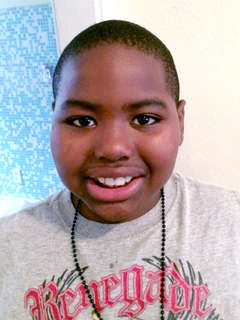
James Sampson
Melrose Elementary School
James Sampson was repeating the second grade at Melrose Elementary in 2014-15. He couldn't make change or read the side of the Rice-A-Roni box. He'd had 12 different instructors that year, including a revolving door of substitutes when his regular teacher went on maternity leave.
James is a big kid, overweight. When he and his sister were bullied for the way they look, James got in fights with other boys at Melrose. His daily behavior reports, chronicled on a calendar sent home to his mother, were full of frowny faces. He was suspended frequently. He missed weeks of school.
He was 9, but being held back meant he was in the same grade as his little sister, who was 7. She could read books that he couldn’t, books on a first-grade reading level.
His mother, Tameka Lindsey, wanted to give Melrose a try when she moved the family into the neighborhood. She had pulled him out of Campbell Park after students brought marijuana to school.
But her son continues to struggle, she said.

Jaquan Henderson
Lakewood Elementary School
Things were not going well for Jaquan Henderson at Lakewood Elementary. It was the 2007-08 school year, and Jaquan was in the first grade. The 7-year-old was throwing temper tantrums, lying down on the floor or hiding under desks, screaming and crying.
His mother, Iesha Coleman, said she would have understood if the school needed to separate Jaquan from the other students for a while, maybe take him into another room to draw. That tactic had calmed him down when he was in kindergarten at a higher-achieving elementary school in north St. Petersburg.
Instead, Lakewood Elementary repeatedly suspended Jaquan from school.
“I couldn’t get out of the parking lot without them calling me to pick him up,” Coleman said.
Jaquan sat at home watching SpongeBob SquarePants instead of learning the fundamentals of math and reading.
Coleman said she was perplexed. Her son only lashed out when he was in school. A social worker’s report from that school year says: “Mother notes youth does well at home, and that the behavior issues only occur in the school setting.”
Then, one day in 2008, Lakewood teachers decided to take an even more severe step after they pinned the asthmatic boy to the floor to settle him down. They had him involuntarily committed to a mental health clinic under the Baker Act.
“I didn’t know you could do that to a first-grader, and without telling the parents,” Coleman said. “They said he had the temper of a grown man.”

Jaymir Wooten
Lakewood Elementary School
His backpack was empty again, and so it was yet another day that Jaymir Wooten had come home without homework. His mother, Tanisha, shook her head. It was almost the end of the school year and still no work home?
She knew it was not supposed to be like this.
But that, she said in the spring of 2015, is how it is at Lakewood Elementary. That year, her son was in the first grade at the school his mother never wanted him to attend. Meanwhile, Jaymir's big brother went to a fundamental school, a special magnet school that can only take a limited number of students chosen by lottery.
There weren’t enough seats for Jaymir.
At Lakewood, Jaymir was one of the smallest boys in class. He said he was picked on in the cafeteria by bigger boys. His favorite "subject" was lunch on Fridays, the day his teacher let him eat in the classroom.
Tanisha said the only time she heard from the school was when the principal called to say Jaymir had received his third referral. He had been patting girls on the behind at recess. He was 6.
Tanisha said she never heard about the first or second referral.
Jaymir likes math and writing and wants to be a singer or dancer when he grows up. His mother keeps entering the school district’s lottery for seats in better schools. She wonders what kind of future he'll have if things keep going like this.
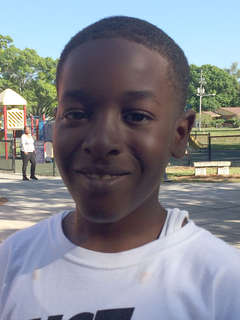
J'len Thurton
Fairmount Park Elementary School
Moe Thurton said he saw fights every day outside Fairmount Park Elementary School.
He and his son, a third-grader in 2014-15, lived close enough that J’len could have walked to school. But because of the violence Thurton saw, he drove his son to school every morning and home every afternoon.
Even then, Thurton, a professional bodyguard and night club bouncer, he started getting out of his car to break up fights. One week in March, he broke up two.
Thurton said he worried about J’len’s education. His son was repeating the third grade. Despite earning decent grades, J'len couldn't pass the Florida Comprehensive Assessment Test. His teachers never called home to say he was struggling with academics, Thurton said. Instead, they said he was disruptive and off-task.
The previous school year, J'len was hit in school and hit the kid back. He received a one-day out-of-school suspension. He has received a few referrals and calls home for being "disruptive." Moe said his son loses focus when he can't understand what's going on in class.
As J’len prepared to enter the fourth grade, Thurton said he was going to stop breaking up fights, worried that his involvement would make his son a target for bullies.

Justin Gilliam
Douglas L. Jamerson Jr. Elementary School
As a first-grader at Douglas L. Jamerson Jr. Elementary, Justin Gilliam started to get in trouble.
Angry over assignments he didn't want to do, he would pout and walk to the other side of the room, or leave class entirely.
But Jamerson is different from most elementary schools in St. Petersburg. A select magnet school, Jamerson has an intervention committee composed of teachers and parents who decide on punishment. Their goal is to start with constructive forms of discipline — counseling, required tutoring, curriculum changes — before resorting to taking kids out of class.
"They figure by suspending a child it doesn't help you learn," Justin’s father, Geoffrey Gilliam, said in the spring.
If Justin hadn’t gotten into Jamerson through a district lottery, he would attend his neighborhood school, Fairmount Park Elementary, where students are more likely to be suspended than to learn to read on grade level.
"If I had him at Fairmount Park, they'd say he was a discipline problem," Gilliam said.
But this was the 2013-14 school year at Jamerson, and administrators placed Justin in a fourth-grade class for a week to give him a break from his normal environment.
There, Justin used a computer to access ST Math, a program used by the school district. The teacher noticed that Justin, despite being three years younger, was outpacing students in her fourth-grade class.
"And then it clicked," Gilliam remembers. Meeting with the principal, Justin's family and teacher agreed that the source of the boy's behavior problems was his intelligence. "You teach him a skill one time, he gets it, he doesn't want to do it again," his father said.
The decision was made: Justin skipped the second grade. Gilliam said the school told him his boy was the first black student to skip a grade at Jamerson.
In the third grade in 2014-15, Justin was happy and earning A’s and B’s, his father said.

Kailel Rohlsen-Jackson
Melrose Elementary School
Kailel Rohlsen-Jackson is the exception to the rule. He spent his entire elementary school career at Melrose Elementary, which he loved. He went head to head with the other kids in math club, loved his teachers, earned good grades.
In fact, Kailel was the only fifth-grader at Melrose to pass both the reading and math FCAT in 2014.
How did he do it? Kailel, a slim kid with glasses who has been picked on, he says, for being a nerd, just loves to learn and spends his free time doing it. At home, Kailel studied at least 10 hours for the FCAT. "I love math," he explains.
It would be hard to credit much else. In the fall of 2014, Kailel was living in a run-down apartment off the highway, next to a 7-Eleven, where his mom worked night shifts and his step-dad slurped Slurpees. He shared a bedroom with a 7-year-old and 23-year-old and he did not like that very much.
Things didn’t look much better at school.
In the second grade, his P.E. teacher threatened to punch one of his classmates in the face for sneezing, according to district records. His third-grade teacher was fired for incompetence, while another one of Kailel’s teachers was cautioned over corporal punishment. His fifth-grade art teacher was fired for having meltdowns, crying in front of students and staff. She was taken from the school’s clinic to the emergency room one day for high blood pressure, according to the records.
Kailel loved Melrose. But when he thinks about it, he said he knew some things were off. Like how often he would be the only kid with his hand up in class. Or how he would listen to the other children tell his teacher they didn't understand their lessons. And she would say, "What part?" and they would say "All of it." And she would just keep teaching.
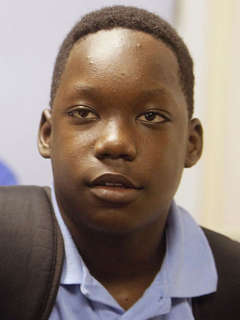
Ke’Andrae Davis
Fairmount Park Elementary School
Ke’Andrae Davis lasted through the second grade at Fairmount Park Elementary. He doesn’t have much to say about his time there. “I really wasn’t learning anything,” the boy, now 13, said in the spring. He shrugged.
“Boys would raise their hands and the teacher wouldn’t call on them. She’d just ignore them, even when they had a question,” Ke’Andrae said. “Our teacher was yelling all the time.”
It seemed like every few minutes, she would stop class. She was furious at a student for talking, or had to wrangle a student who was out of his seat, Ke’Andrae said: “It was bad. People were running around all over the place … I really wasn’t learning nothing.”
His mother pulled him out of Fairmount Park after he was suspended for fighting in the second grade, Ke’Andrae said. He went to a private school that his family affords through tax credit scholarships for low-income families.
In early 2015, the sixth-grade student flipped through his composition book at Bethel Community Christian School. There were fewer students in his classes, and he felt like his teacher cared about him. For the first time, he had made honor roll. “That felt good,” he said, and cracked a smile.

Laneise Garcia
Bay Vista Fundamental
Laneise won the lottery, and on she went to a fundamental school.
“That’s the type of school where parents are involved and care, and that’s what I want my kids to be around: positive people,” said mom, Lafara Wright, in the spring.
At Bay Vista Fundamental Elementary School, Wright gets along with all of her daughter’s teachers, she said, and hears from them all the time. They meet with Wright frequently, discussing Laneise’s grades.
In the spring of 2015, the second-grade girl was an honor roll student who did all the work she brought home.
Because Laneise won a seat at Bay Vista, her little sister got to go too. Celiyah was in kindergarten and also acing her report cards, Laneise said.
Wright said she worked at Pinellas Secondary, an alternative school. Most of the students end up there because of behavior problems. Wright knows that fundamental students almost never do.
“I think that's how all schools should be,” she said, “but I guess they can’t all be.”
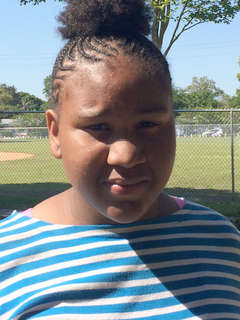
Lashelle Davis
Douglas L. Jamerson Jr. Elementary School
Lashelle Davis never had to find out what life was like inside one of the neighborhood schools near her south St. Petersburg home. Her mother didn't even tour the F school Lashelle was zoned for.
Instead, she entered Lashelle in the district's lottery for special assignments, and the girl won a seat at Douglas L. Jamerson Jr. Elementary, an A-rated magnet specializing in math, science and engineering.
“Things that would make her successful,” mother India Johnson noted, beaming.
Lashelle was in the fourth grade at Jamerson in the spring of 2015, earning A's and B'. Johnson said she's the type of parent who “will call a meeting in a minute” over any issue, and Jamerson's staff was “always willing to help me.”
Lashelle got plenty of homework home. “Especially reading. It’s all about their academics and being successful,” Johnson said. “My goal for her is to be successful.”
Johnson works at the Enoch Davis Center in south St. Petersburg, close to a different St. Petersburg elementary school, Melrose. It is the worst-performing elementary school in the state, based on an analysis of math and reading scores by the state education department.
Because Johnson felt so blessed to have Lashelle at Jamerson, she decided to mentor a second-grade girl at Melrose during the 2014-15 school year. She was in the school each week working with the girl.
“I’m trying to make a difference and I love my mentee so much. She’s so excited to see me every time,” Johnson said.
Then Johnson’s face fell.
She said that each time she visited Melrose, she saw kids running wild, knocking things over and screaming, teachers struggling to maintain control for more than a few minutes. She said she thought, “Uh uh uh, no, my daughter couldn't go there.”

Marques Johnson
Fairmount Park Elementary School
Christina Johnson had a brief but memorable experience with Fairmount Park Elementary.
She enrolled her son, Marques Johnson, there in the 2010-11 school year after the family moved. Almost immediately, Marques, then a fifth-grader, came home with troubling stories. He said that the other students cursed at the teacher and the teacher cursed back.
His new class was behind, too, in the curriculum. He was repeating lessons he had done at his old school. Marques, a bright student, was bored.
Within three months, Johnson decided to enroll him in a private school. With the help of a state tax-credit scholarship, Marques spent the next three years at Mt. Moriah Christian Fundamental Academy. He was valedictorian of his eighth-grade class.
Looking back on it, Johnson said she wished she had known there was such a difference between Fairmount Park and other typical elementary schools. If she had, she wouldn't have moved.
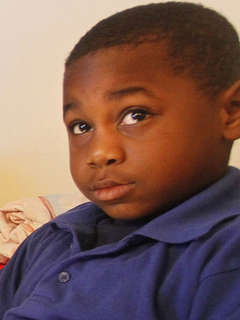
Master Jeremy Grier
Melrose Elementary School
Janelle Larry has two young children: Master Jeremy Grier, and his little sister, Princess Isis.
Master Jeremy was the first up to attend Pinellas County Schools. He started preschool at Melrose Elementary.
Because of what happened there, Larry’s children never went on to kindergarten in the public schools.
Master Jeremy had trouble communicating with his teachers about needing to go to the bathroom. The boy has a speech delay. His teachers put him in a pull-up diaper. It was humiliating, Larry said.
The children at Melrose were physical. Master Jeremy was suspended from school for pushing a boy who Larry says was aggressive with him — still, while he was in prekindergarten.
After barely scratching the surface of the Pinellas public school system, his parents resolved to avoid it all costs. In the fall of 2014, the family was taking three city buses every morning just to get their 6-year-old son to a private school.
It took them than 2 hours, round-trip, every day.
Myles Bradley
Maximo Elementary School
It was a fall day in 2012 when Myles Bradley dropped a Lego on the floor of the Maximo Elementary cafeteria. A classmate picked it up. Myles, then 10, asked him to give it back. The other boy refused.
You might imagine the two boys arguing or Myles running off to tell a teacher.
Instead, Myles was attacked.
The boy who stole his Lego ran around the table and punched him in the face. He put Myles in a chokehold, lifting the boy from his seat as he squeezed the air out of him.
Then he threw Myles to the ground. He stomped on him, over and over, as Myles screamed.
Finally, an adult intervened. It was a cafeteria worker.
“He came around the table and threw me down to the ground.”

Nakayae Moore
Fairmount Park Elementary School
Nakayae Moore went to Fairmount Park Elementary for one year. That was more than enough, her grandmother said. Sylvia Wells Moore feared for her granddaughter in the “out of control” classrooms and hallways.
Nakayae was in the first grade. At the school’s open house, her teacher posted photos of all her students on the wall.
Except Nakayae. She forgot her, and the girl was “devastated,” Moore said.
From day one, Moore said, she felt like the adults in the school didn't care about her granddaughter.
Nakayae’s grades were “horrible” — D’s and F’s — but there was little communication from the school about her academic performance.
“We thought she was doing well in subjects,” her grandmother said. But when report cards came, “it was the opposite of what we thought.”
Moore said she believes some families must have better experiences at Fairmount Park than hers did.
“Going to that school is like rolling the marbles and seeing what happens,” Moore said.
Nakaye now attends a private school, where she enjoys smaller class sizes and individual attention. She's pulled her grades up to B's and C's, Moore said.
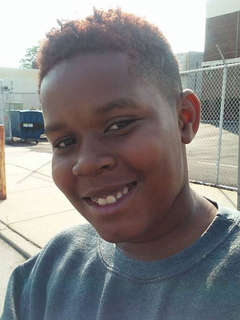
Nafis Bullock
Campbell Park Elementary School
When Nafis Bullock recalls his fifth-grade year at Campbell Park Elementary, he remembers belts: Kids holding them, chasing him, hitting him when they caught up to him, all in front of their classroom teacher.
"I told her, but she wouldn't listen," Nafis said. "She wouldn't do anything about it."
Nasif is a polite, sweet boy, who always says "please" and "thank you," to his teachers, said his mother, Tammy Bullock. She believes that's why he is a target.
Bullock began sitting in on Nafis’ classes to try to protect him.
"The kids were going buck wild in class and (the teacher) did nothing," Bullock said. "They were rolling chairs, spinning, falling out of chairs, pushing each other out of chairs."
The bullying got so bad that Nafis had to switch classrooms in the spring of 2014. It was better, he said, but he still got slapped and kicked by the kids who called him names in the hallways.
"I was disgusted,” said Bullock, who was the PTA president at the Pennsylvania school Nafis attended before coming to Campbell Park. “My children were being harmed tremendously while they were trying to learn."

Olivia Anderson
Homeschooled
Kimberly Anderson isn’t rich, and her life isn’t easy. The home she was raising her children in on 16th Street S was broken into five times, the last time while they were at a Christmas party. They came home to ruins.
Though she doesn’t have much, Anderson said she does have something that made all the difference: eyes open about her neighborhood public schools.
When it came time to send her oldest child, Olivia, to kindergarten, Anderson said she knew enough to know Campbell Park Elementary wasn’t an option.
Running her own preschool, Anderson watched as children who knew all their letters and phonetics fell apart at Campbell Park by the second grade. “Those were the building blocks of reading,” Anderson said. “And all of a sudden, two years later, the school’s saying they can’t read?”
At church, she heard the stories about brutal fights in elementary school classrooms. She talked to teachers who said their hands were tied by a curriculum they didn’t believe in.
“And I’ll never forget the article about the 5-year-old girl arrested at Fairmount Park,” Anderson said. “I mean, to arrest a 5-year-old.”
In 2005, police arrested the girl after she threw a tantrum, tearing papers off the wall, climbing on a table and hitting a staff member.
So when Olivia started kindergarten in 2009, it was as a homeschool student, with her mom as her teacher.
“It’s a huge time commitment,” Anderson said. “I’m responsible for creating the lesson plans, appropriate projects. I am the field trip director.”
Not to mention, “It’s a financial strain.” Anderson has had to purchase her children’s curriculum.
But she said she knows her sacrifice is worth it.
“I never had to deal with them fighting, or going through that potty-mouth period, wondering where they picked up horrible words,” Anderson said. “Public school was just never an option.”

Salimah Bullock
Campbell Park Elementary School
Ten minutes into her first day at Campbell Park Elementary, Salimah Bullock got a special kind of orientation.
"Tell me your name — or I'll punch you in the face," a male classmate yelled at her.
Salimah, a quiet girl who loves drawing kittens and anything pink, was stunned into silence.
The boy swung.
Her mother, Tammy Bullock, was irate. She said no one at the school told her about the incident until she came to pick Salimah up at the end of the school day.
Throughout the 2013-14 school year, when Salimah was in the second grade, she was constantly bullied.
"They cursed at me and called me ugly and threatened to put their hands on me," Salimah said.
"In class, they knocked desks over and cursed at our teacher and knocked the teacher over. Sometimes they would just leave and roam the halls."
Salimah made it halfway through the year before she got seriously hurt.
On Feb. 11, 2014, she got caught between two boys fighting. One of them slammed her head against the classroom wall.
Bullock said Salimah sat in the nurse's office all day, holding ice to her head and complaining of nausea.
When Bullock arrived to pick Salimah up from school, she had an ambulance take her daughter to All Children's Hospital.
"It really got to the point where there was so many (incidents), I had to get the police involved," Bullock said.
Salimah stayed on the honor roll, but it was tough, she said. "I couldn't really pay attention because when the teacher was trying to teach, it was loud in the classroom. I didn't get to learn what I was supposed to."
At the end of the year, Bullock decided to move Salimah and her brother back to Philadelphia rather than spend another year at Campbell Park.
“I’ve never seen anything like this in my whole life,” Bullock said of Campbell Park. “It led me to believe that God didn’t want my family in Florida.”
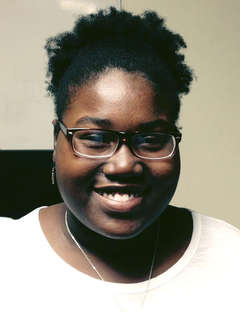
Shenyah Ruth
Madeira Beach Fundamental
Shenyah Ruth’s parents live in a neighborhood zoned for Lakewood Elementary. But they never even considered sending their daughter there. For years they paid for private school.
“The standards and expectations were so much higher than what we were hearing from our public schools,” Shenyah’s mother, Stephanie Ruth, said of the Christian academy.
After elementary school, they played the lottery for competitive district application programs and won a coveted seat at Madeira Beach Fundamental K-8.
It was a long commute, but in the spring of 2015, the eighth-grader’s mother said it was worth the hassle.
She was happy to drive her daughter 35 minutes each way to avoid the middle schools in south St. Petersburg, which she said have a reputation for being violent and plagued by students who disrupt class.
“We were willing to make the sacrifice. Whatever it took to make sure she got a good education,” Ruth said.
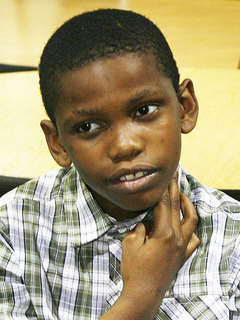
Tashawn Roberts
Maximo Elementary School
Teyosha Pippen realized one morning a few years ago just how much her son was struggling. It was time for him to go to school, but he wouldn’t get off the couch.
Then in the second grade at Maximo Elementary, little Tashawn Roberts told his mother he had a stomach ache, that he was too sick to go to school. Pippen, a nurse, called in to work so she could stay home with her son.
Halfway through the day, Tashawn told her the truth: He wasn’t sick, but scared to go to school. The day before, he had been talking during class. And his teacher had yelled at him in front of his classmates and told him not to return to school the next day.
Pippen cried. Things had been so much different for Tashawn when they lived in Ocala, in Marion County, the previous year. His teachers cooed about him. He won awards for best-behaved student and earned top grades.
But when she moved Tashawn in 2011 to St. Petersburg, everything started to change. “Here it's like he’s this bad student,” Pippen said in late 2014.
He was suspended at Maximo for fighting. She pulled him out, took him to Campbell Park Elementary in search of a better education for her son. But, “It was horrible from the beginning.”
Pippen wrote notes to Tashawn’s teachers. She said they never responded. He had four teachers in the first three months of school at Campbell Park. Two walked out in the middle of teaching, Pippen said.
Tashawn was bullied, got in fights and was sent home all the time. His teachers said they couldn't control him. His mother had him tested for attention disorders twice. “The doctor said the only thing wrong with Tashawn is that he’s too smart,” his mother remembered.
Tashawn recently recorded a 135 IQ, his mother said. He began receiving gifted services in the fourth grade at Campbell Park.
But at the same time, his grades steadily dropped. Tashawn was beaten up in the back of his fourth-grade classroom. His A’s and B’s became C’s and D’s.

Tia Daniels
Campbell Park Elementary School
Every day, Tia Daniels lost a little piece of her education to fear.
In the spring of 2015, she left her classes at Campbell Park Elementary 15 minutes early so she could walk home before the boys caught up with her.
The year before, in second grade, a boy patted Tia on the butt. In third grade, two boys tried to trap her in the bathroom while they made sexual remarks and called her degrading names.
When her mother complained, administrators said it would be too difficult to transfer both boys out of Tia’s class, said her mother, Karen Rarick. Instead, they transferred Tia to another third-grade classroom.
She was then in the same class as the boy who touched her the previous year.
“I thought they had a control on the situation with these boys, but they’re sending her from one situation to another,” said Rarick.
If only that was it.
In the spring, the school agreed to let Tia leave early every day. There was a group of boys that would follow her home, taunting her.
Rarick said she thinks they’re connected to the gang that fired bullets into their house the year before, when Rarick and Tia and the rest of the family were home.

Tyree Parker
Maximo Elementary School
On his first day of school at Maximo Elementary, Tyree Parker ran to the desk with his name tag on it and gleefully shouted, “This is my desk!”
His kindergarten teacher was at the front of the classroom talking with Tyree's grandmother, Loneiyce Washington.
According to Washington, the teacher was surprised by Tyree’s declaration. “He can read?” she asked, eyebrows raised.
Washington replied, “You mean the other children can't?”
Tyree and his grandmother moved to Pinellas in the fall of 2014 and he started at Maximo Elementary the same year the school got its fifth F from the state.
“I'm not understanding how four- to five-year failing schools are existing,” Washington said. “I don't know what's going on in south St. Pete but it's not one thing. It's everything.”
The problems began immediately at Tyree’s new school. His prized Teenage Mutant Ninja Turtle hat, with bulbs that lit up when he squeezed them, was ripped apart by another boy.
Twice, Washington said, Tyree was hit in the cafeteria by other children. She found out through notes in Tyree's planner. “Tyree was hit in the cafeteria today,” the notes said. Nothing else.
Washington said she tried everything to make sure her grandson was safe. Around Christmas, she petitioned Maximo to allow Tyree to switch to a new kindergarten class.
In the new class, when Tyree went to use the bathroom, Washington said another boy followed him in, closed the door, and began tearing Tyree’s pants off.
She was so enraged that she called the police to her house.
She said she also left a message and sent a letter to the school, but got no reply. It wasn’t until she faxed the area superintendent, Robert Poth, that she got a meeting.
Meanwhile, Tyree’s grades slipped. In reports home, his teacher said he couldn’t identify shapes or do simple counting exercises — things he could do before he started at Maximo.

Zaniyah Durant
Maximo Elementary School
For a while, Lakita Simmons wondered what was going on in her youngest daughter's classroom at Maximo Elementary.
Zaniyah Durant, then a first-grader, seemed to come home every day with a frown and stories about other students' antics.
So after the winter break, in 2014, Simmons decided to visit. What she saw shocked her.
“It looked like a zoo in there,” she said.
Simmons said the teacher, a nine-year veteran, had no control over her class. Children were crawling on the floor and running around while she was trying to teach. One child was making animal noises during the lesson. It was impossible for the children who were paying attention to learn anything, Simmons thought.
After that, she decided to move both of her children to a private Catholic school.
“I didn't want to go directly into that. I wanted to at least try the public school,” she said.
Zaria Anderson
Campbell Park Elementary School
One day, in the spring of 2012, Zaria Anderson filed a bullying report against two girls who wouldn’t leave her alone.
The 11-year-old had spent years fending them off at Campbell Park Elementary. They followed her into the bathroom; they called her names in the lunch room.
Her mother, Tammie Jenkins, spent her days researching a move — so that Zaria could finally get away from these bullies, come middle school. Jenkins always told her daughter: Don’t fight back. You’re better than that.
And so Zaria did what she was supposed to. She filed the bullying report.
The next day, as she was walking to Campbell Park, the girls caught sight of the Zaria.
They followed her. They started throwing sticks at her. They shouted at her, saying Zaria was “scary.”
After a few minutes of this, they reached the school. One of the girls punched Zaria and pushed her down on the sidewalk. Soon both of her attackers were on top of Zaria, kicking and punching her. One of the girls gave the other directions: to use an upper cut, exactly how and when to hit her.
They stole her phone and her backpack, Jenkins said. Zaria’s prescription eyeglasses were lost in the scuffle. It was another year before Jenkins could buy her daughter the new glasses that she needed to see.
After that, Zaria told her mother she was afraid to go to school.
“These are fifth-graders we’re talking about, not 12th-graders, so I thought it was ridiculous,” Jenkins said. “Who jumps a little kid and takes their stuff, in the fifth grade?”
Eventually, Jenkins told her daughter to fight back. In the 2014-15 school year, Zaria was suspended from school for 10 days for doing just that.
She had to, Jenkins said. “You get bullied so long. Until you fight back, you get labeled that you’re not going to fight, so everybody picks on you.”
“Who jumps a little kid and takes their stuff?”

Zariah Mccallister
Fairmount Park Elementary School
Zariah’s mother, Zakevia Peterson, has been trying for years to get her out of Fairmount Park.
She was tired of seeing fights break out and watching third-graders threaten kids in kindergarten, she said.
And that’s not the worst of it.
“They use words that I don't know,” Peterson said. “They say stuff where I’m like, what do you do, sit and home and watch pornos? They say the most disgusting stuff."
Zariah, previously a model student, started to misbehave as a first-grader in the 2014-15 school year.
“I'm not saying my daughter is a follower, but I’ve had the teacher tell me my daughter would follow around another child, doing something she's not supposed to do,” Peterson said. “You know, like hopping around the classroom, distracting the class. When it's time for her to teach, she has to stop and talk to these two children.”
Peterson said the school needs more structure and more behavior specialists to help children who struggle to stay in line.
As the new school year started, she waited on word from the district about Zariah’s application to Douglas L. Jamerson Jr. Elementary, a nearby magnet school. She was No. 1 on the wait list.
Peterson said, “I pray every night (she) ends up at Jamerson.”

Zariyah Durant
Maximo Elementary School
At Maximo Elementary, Zariyah Durant had three teachers before she left kindergarten.
By the time she reached third grade at the F-rated school, seven different teachers had cycled in and out of her classrooms. Even more if you count the many days she had substitutes.
She said the revolving door sowed chaos in her classroom and made it next to impossible for her to learn. In the end, the girl had to repeat the third grade.
“A lot of people were cussing, standing on desks,” Zariyah, now 10, recalled. “They were hitting teachers on the back and the head. It was hard to focus.”
The substitutes were so overwhelmed, she said, that they couldn’t tell the students apart. Some days, they sent home notes with every child saying the whole class had behaved poorly.




Join the conversation
Add your thoughts